69 Types of Trees in Ohio (With Pictures)
-
Ashley Bates
- Last updated:
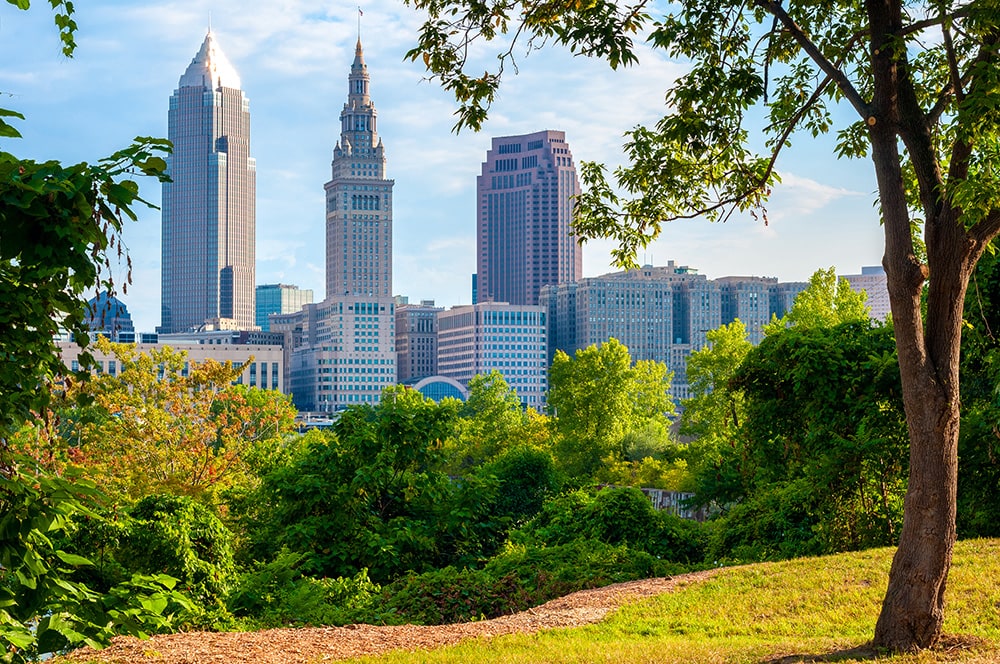
Ohio is full of beautiful scenery, from lush, rolling forests to open plains. In this beautiful state, you might wonder about all the beautiful trees that you might find.
Here, we will go over a list of all the trees you might see in Ohio, whether you are a resident or a tourist.
Deciduous Trees
Deciduous means “falling off at maturity,” indicative of the leaves dropping every fall and repopulating in the spring. Here are those such trees in Ohio.
The 69 Types of Trees in Ohio
Beech Family
1. American Beech
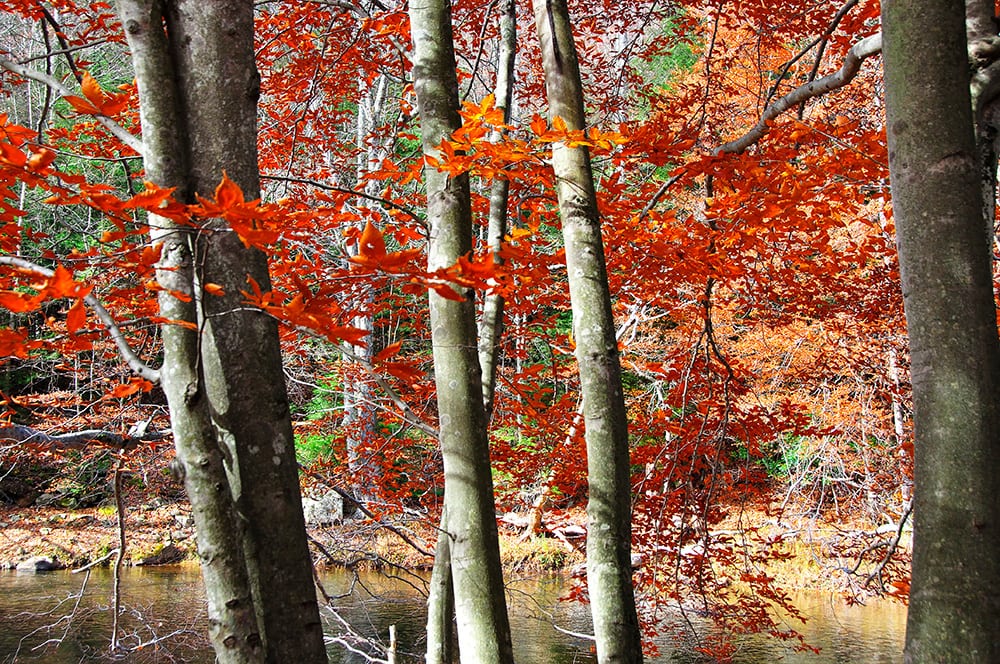
| Height: | 50-70 feet |
| Spread: | 35-40 feet |
The American Beech tree has smooth gray bark and grows whimsically with twisty branches. Something unique about the American Beech is that they rarely lose their brownish yellow leaves in the winter. Often, new leaves in spring have to push them off.
2. American Chestnut
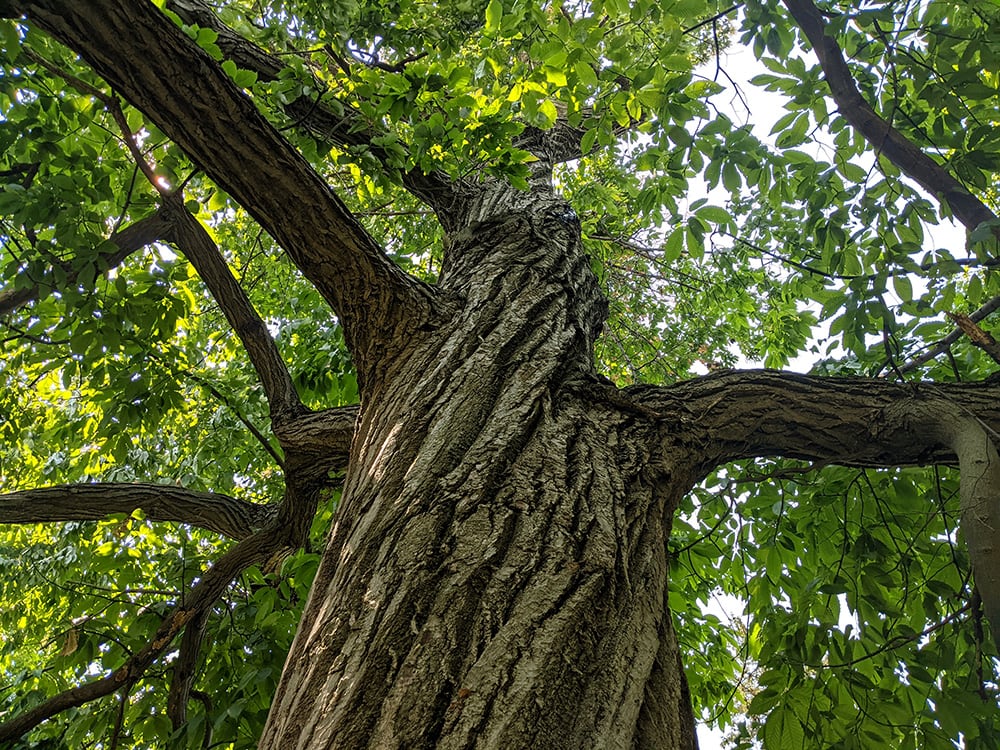
| Height: | 60-90 feet |
| Spread: | 60-120 feet |
The American Chestnut is a sizable tree with exciting leaf patterns and fruit. These trees produce the edible chestnuts we love, developing tons of fruits yearly.
3. Black Oak
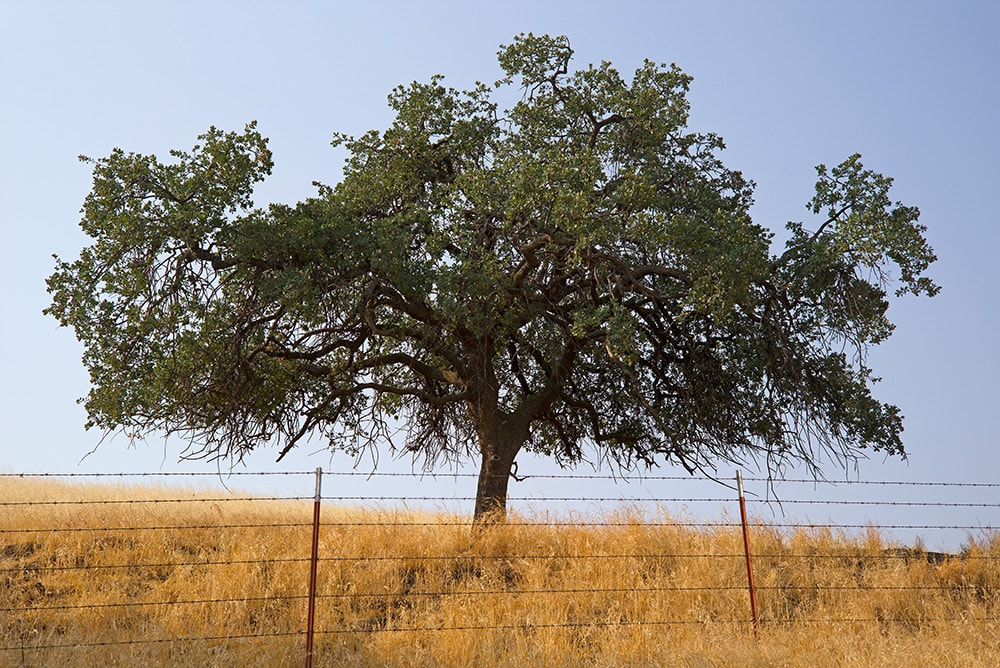
| Height: | 60-100+ feet |
| Spread: | Irregular |
Black Oak trees are highly useful for surrounding wildlife, as they produce acorns for nourishment. These trees get very thick and tall with simple leaves and black bark—and they can get massive as they grow.
4. Bur Oak
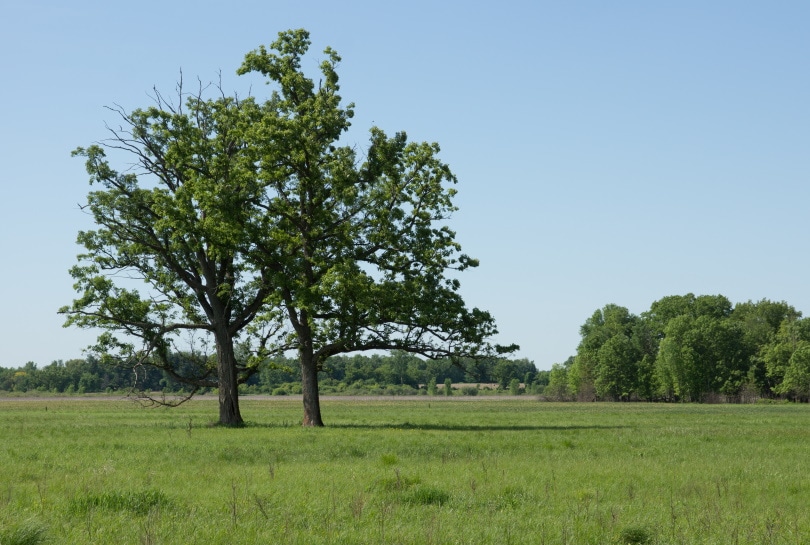
| Height: | 70-80 feet |
| Spread: | 80 feet |
The Bur Oak is one of the slowest growing of species. These trees grow nicely outward, providing optimal shade coverage. Like other oaks, they produce acorns for wildlife.
5. Chestnut Oak
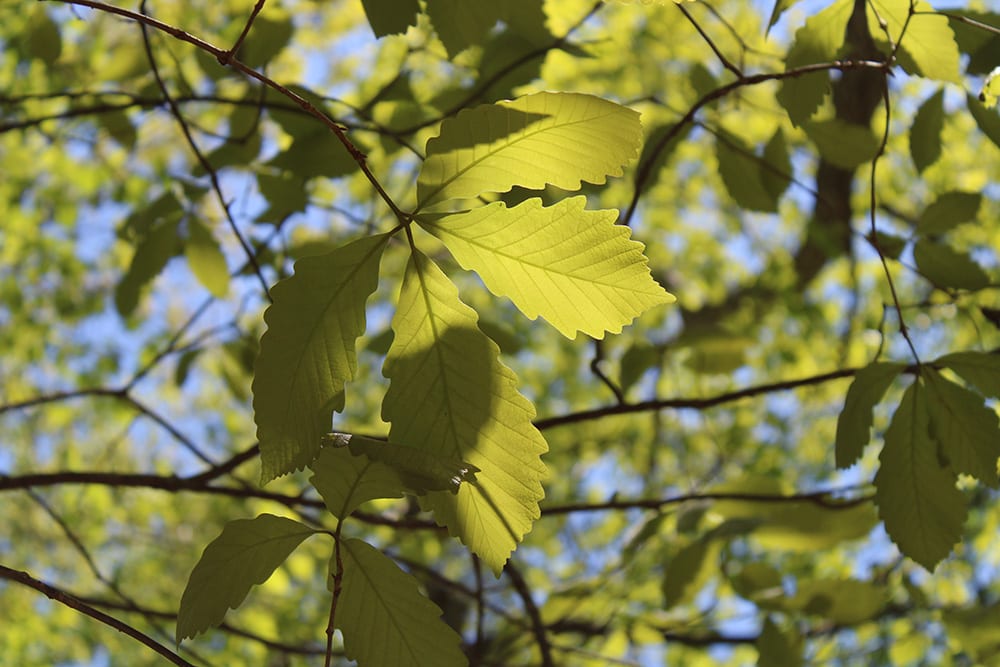
| Height: | 60-70 feet |
| Spread: | 60-70 feet |
The Chestnut Oak has a very distinct appearance apart from its oak cousins due to the deep, shiny green leaves and dark, chocolatey acorns. It’s often an excellent choice for yards due to its shade coverage, reaching 70 feet wide.
6. Chinkapin Oak
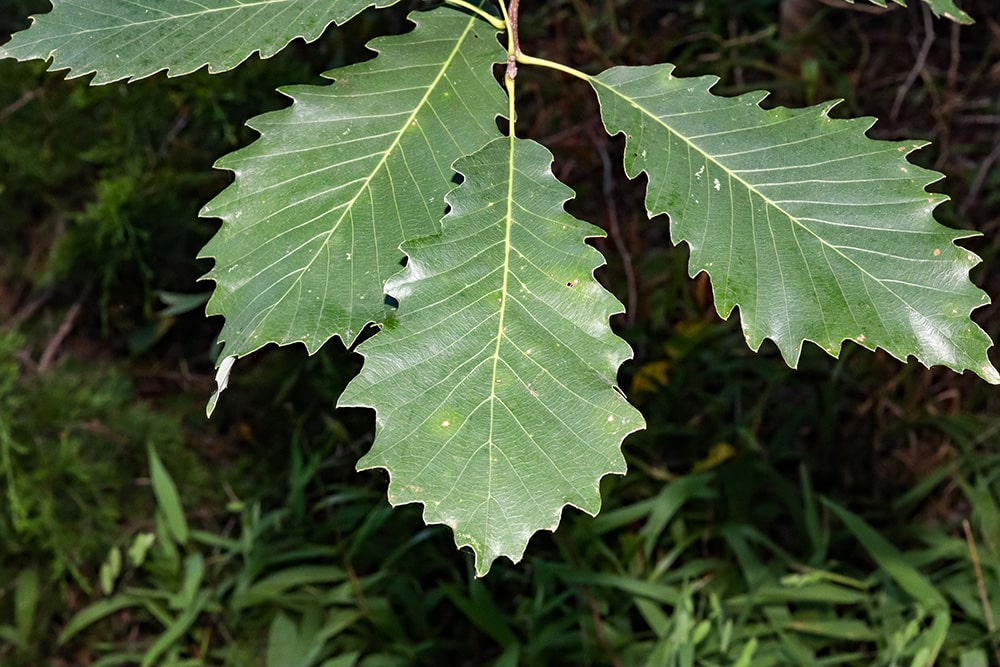
| Height: | 40-60 feet |
| Spread: | 50-60 feet |
The Chinkapin Oak is a gorgeous flowering oak tree that produces green across until ripe—then they turn nearly black. You might also recognize the Chinkapin because it is smaller and stouter, sometimes giving a shrubby appearance.
7. Northern Red Oak

| Height: | 60-75 feet |
| Spread: | 45 feet |
The Northern Red Oak is a hardy oak variety with bristly leaves. It’s one of the fastest-growing oaks. These trees are brilliant in the fall, giving way to rusty red hues—gorgeous against other fall varieties.
8. Pin Oak
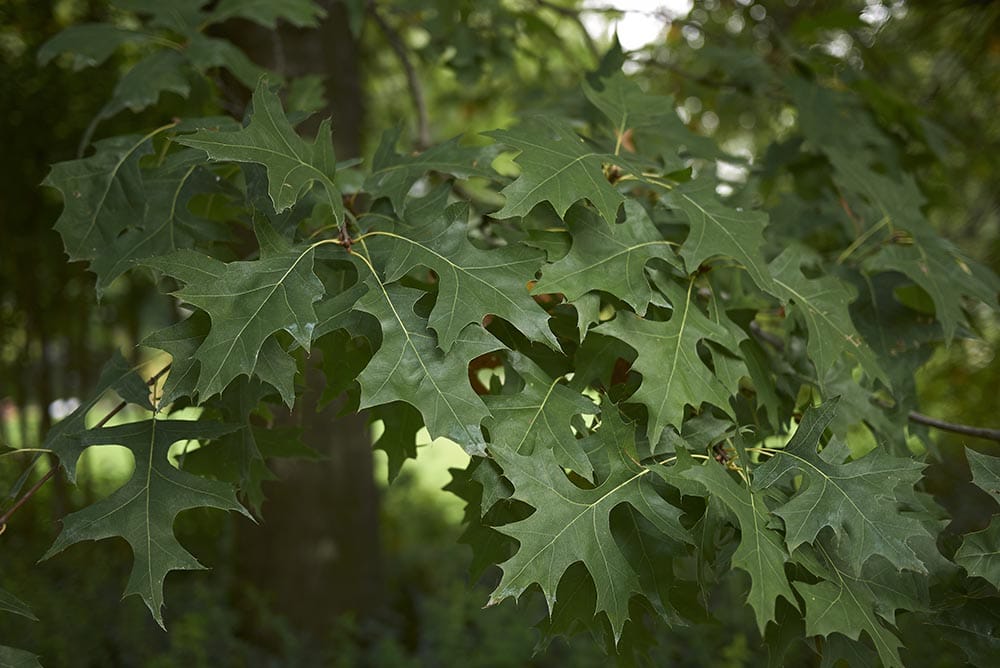
| Height: | 60-70 feet |
| Spread: | 25-45 feet |
The Pin Oak is an upright tree that is often triangular-shaped early and oval-shaped later. Its unique branching pattern produces saucer-shaped acorn caps with round fruits.
9. Scarlet Oak
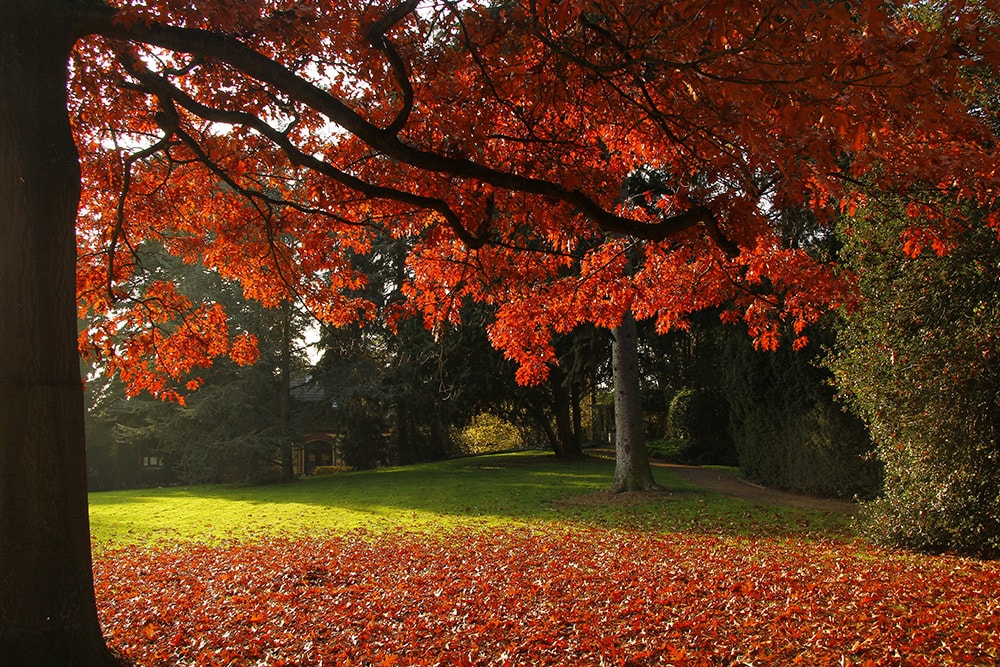
| Height: | 60-80 feet |
| Spread: | 40-50 feet |
The Scarlet Oak is a fast-growing beauty that turns a brilliant scarlet color in the fall—hence the name. Many people love the aesthetics of a Scarlet Oak because it grows in a lovely rounded shape.
10. Shingle Oak
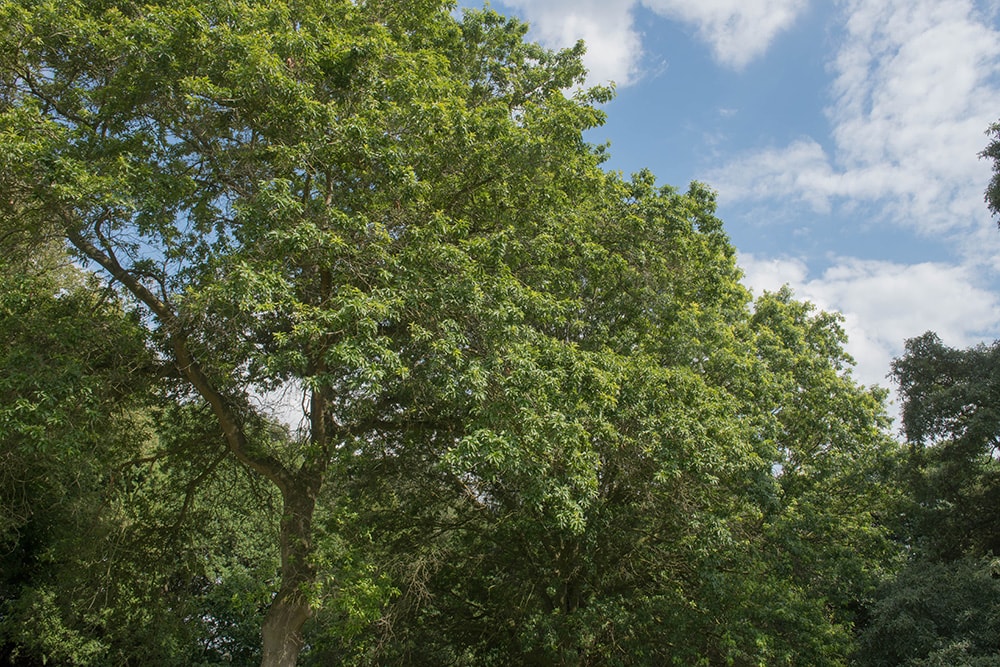
| Height: | 50-90 feet |
| Spread: | 60-90 feet |
Shingle Oaks are less common than many other beech species. However, the bark used to be fantastic for making shingles, giving way to the name. .
11. Shumard Oak
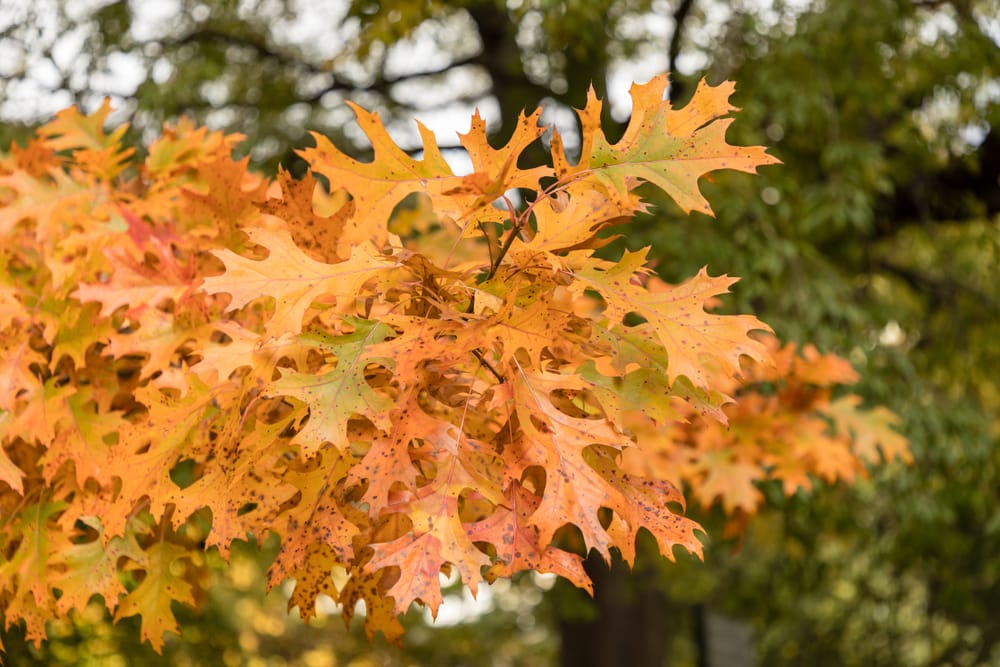
| Height: | 40-60 feet |
| Spread: | 40-60 feet |
The Shumard Oak is one of the largest in the red oak category. These oaks are super hardy, working well in even unfavorable soils—and it’s even drought tolerant.
12. White Swamp Oak
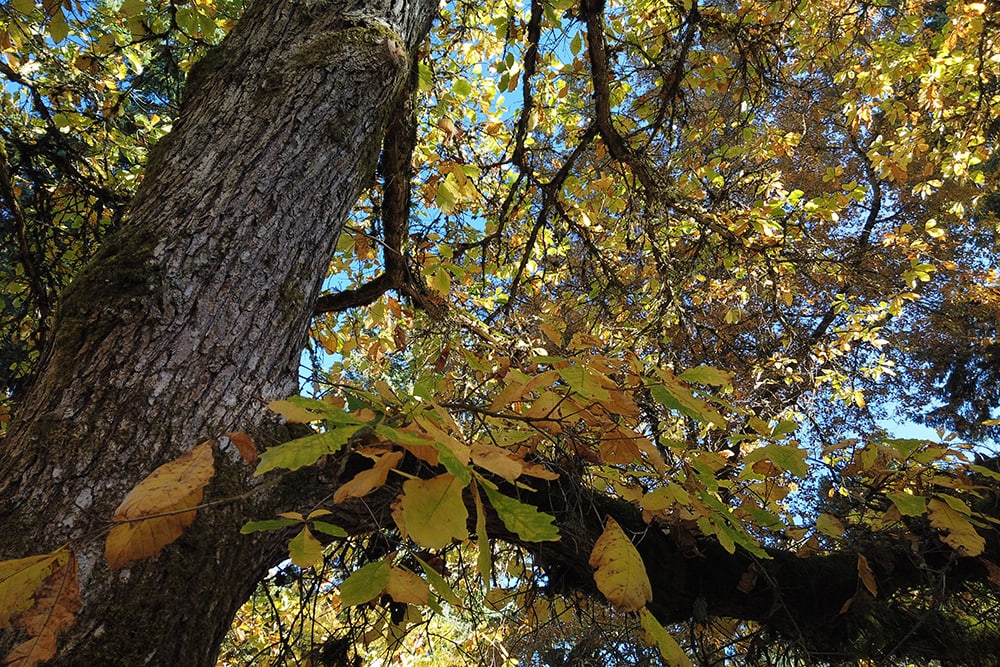
| Height: | 50-60 feet |
| Spread: | 50-60 feet |
The White Swamp Oak is a very hardy tree that thrives in all sorts of poor conditions. It is especially attractive to birds, providing food and adequate shelter to house wildlife—including its long paired acorns.
13. White Oak
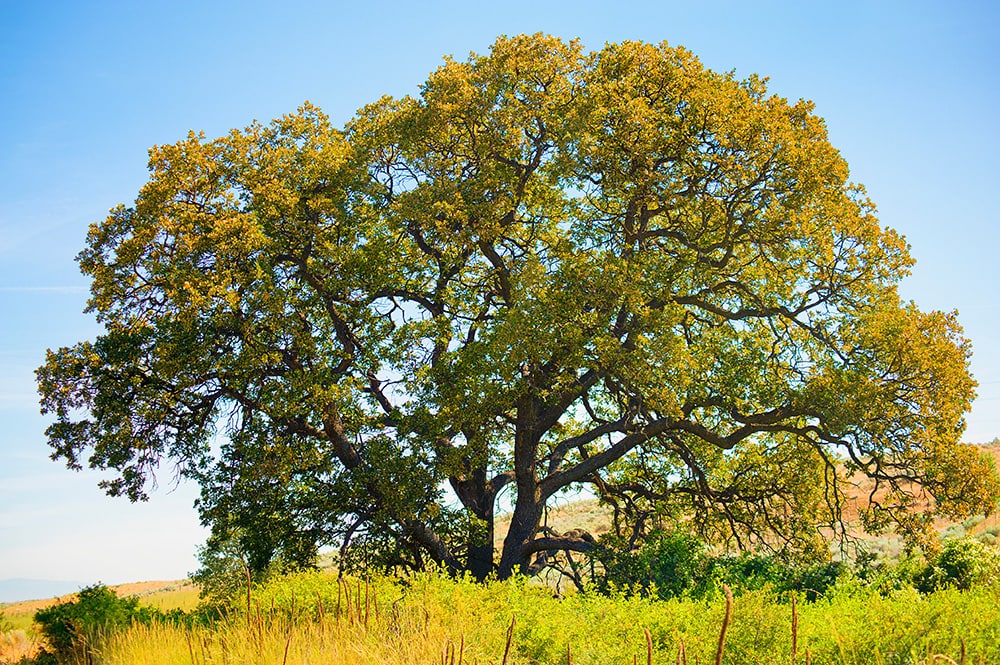
| Height: | 50-80 feet |
| Spread: | 50-80 feet |
The White Oak definitely has a presence, touting a thick, stout trunk and outstretching limbs and branches. These trees are ancient and are capable of living for centuries.
Bean Family
14. Black Locust
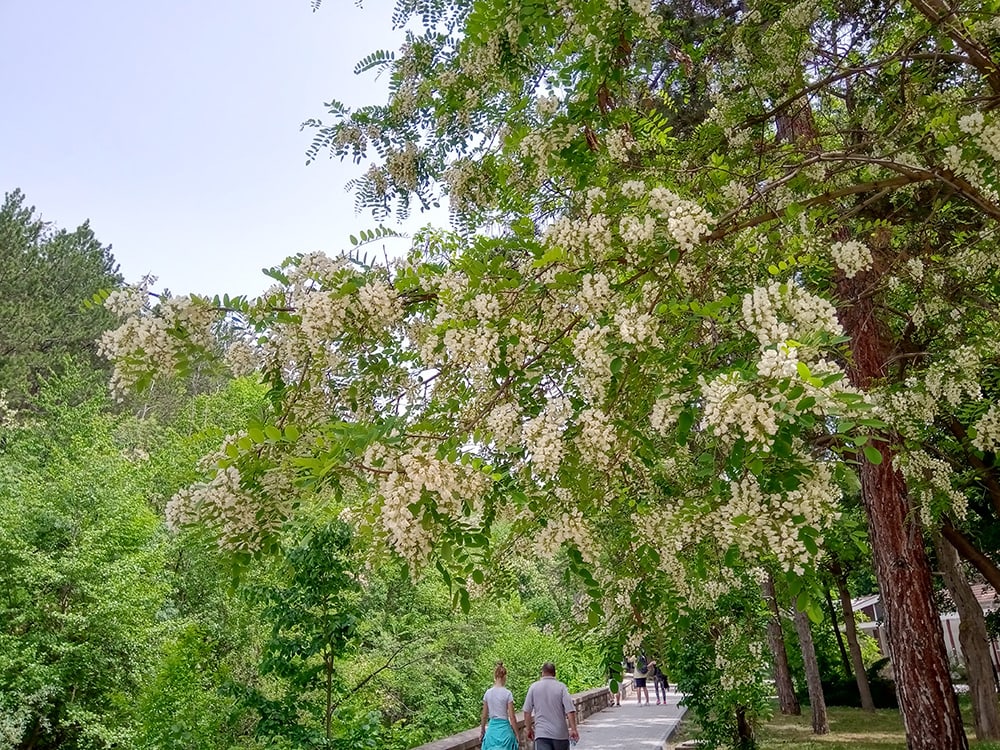
| Height: | 60-80 feet |
| Spread: | 20-30 feet |
The Black Locust tree is a fast-growing, fragrant springtime favorite. While it gets a bad reputation for rapid growth, it produces beautiful, dropping flowers and lovely foliage.
15. Honey Locust
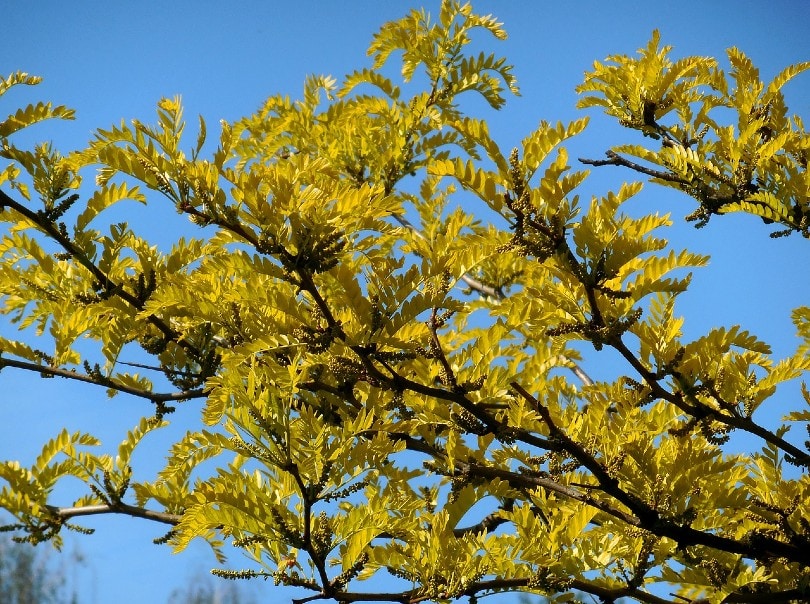
| Height: | 70-130 feet |
| Spread: | 30-70 feet |
The Honey Locust is a very recognizable tree because it has long, spiky thorns that stick outward. However, some are thornless, making them more desirable for landscapes.
16. Kentucky Coffeetree
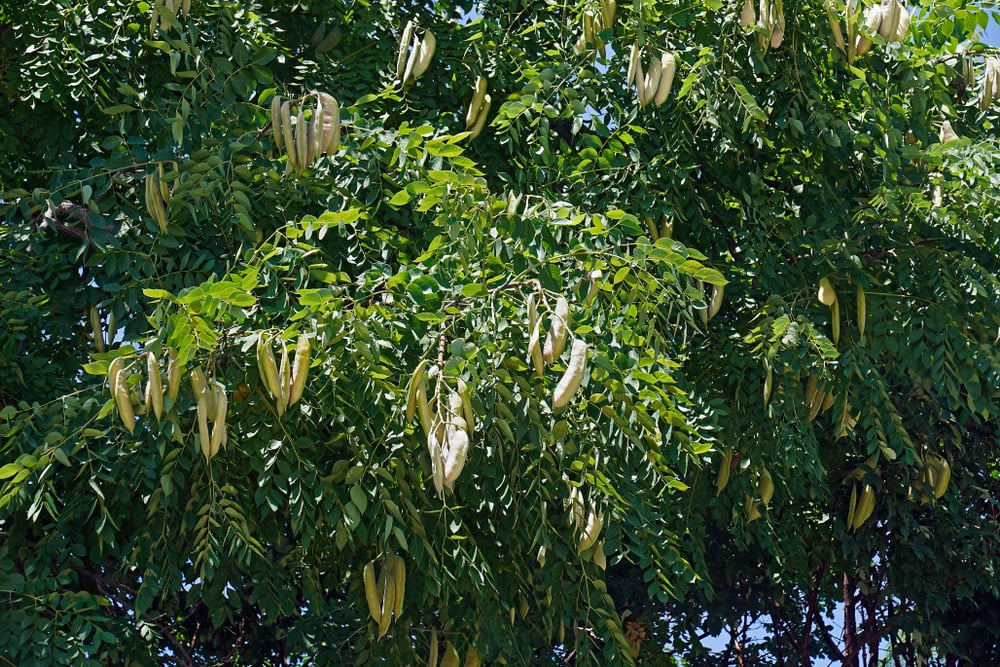
| Height: | 60-75 feet |
| Spread: | 40-50 feet |
You’ll know the Kentucky Coffeetree right away in late May and early June. It develops greenish-white flowers along with leaf blooms that smell similar to roses. They are late bloomers, though, being one of the last to sprout.
Bignonia Family
17. Northern Catalpa
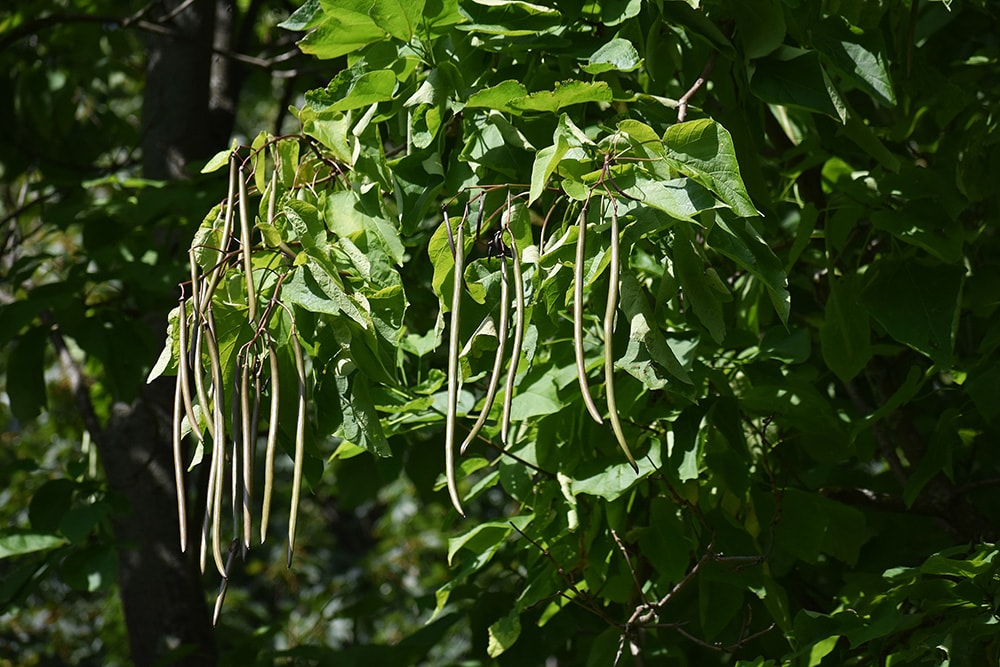
| Height: | 40-60 feet |
| Spread: | 20-40 feet |
The Northern Catalpa is the only type of Catalpa tree that is native to Ohio—and the only in the Bignonia family. It’s instantly recognizable due to its large leaves and cigar-like pods.
Birch Family
18. Black Birch

| Height: | 45-50 feet |
| Spread: | 25-45 feet |
Black Birch trees are typically aesthetically pleasing with straight, smooth stalky bark and symmetrical outreach. Unlike traditional birch you see, the bark is very dark brown. It grows male and female catkin flowers.
19. River Birch
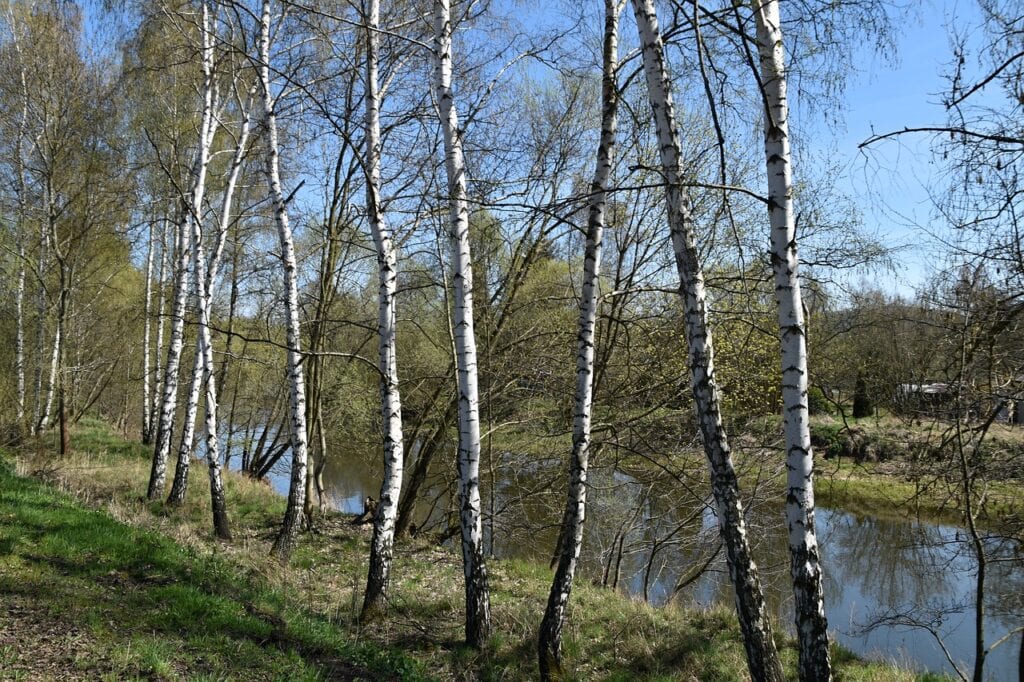
| Height: | 40-60 feet |
| Spread: | 40-70 feet |
The remarkable River Birch has a unique appearance. Its bark gives the illusion of shedding or peeling. It gives it a rustic and standalone look, making it easy to identify.
20. Yellow Birch
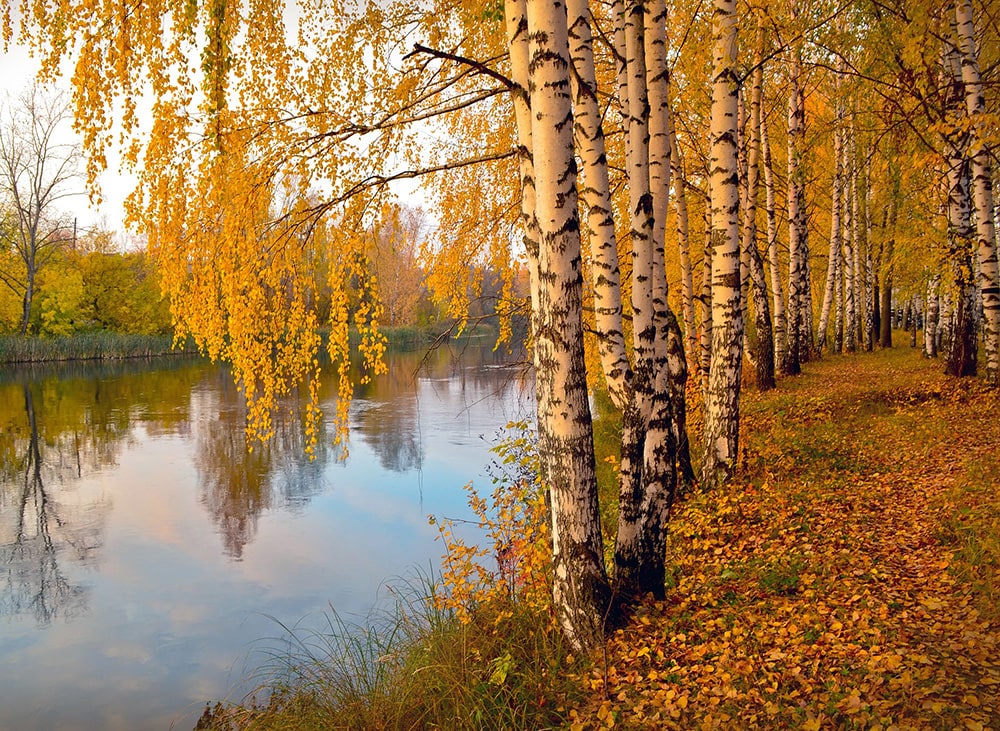
| Height: | 60-75 feet |
| Spread: | 35-50 feet |
The Yellow Birch is a tall, slender tree with attractive foliage true to its name. Its bark is both smooth and rough in patches contrasting nicely between light and dark.
Elm Family
21. Hackberry
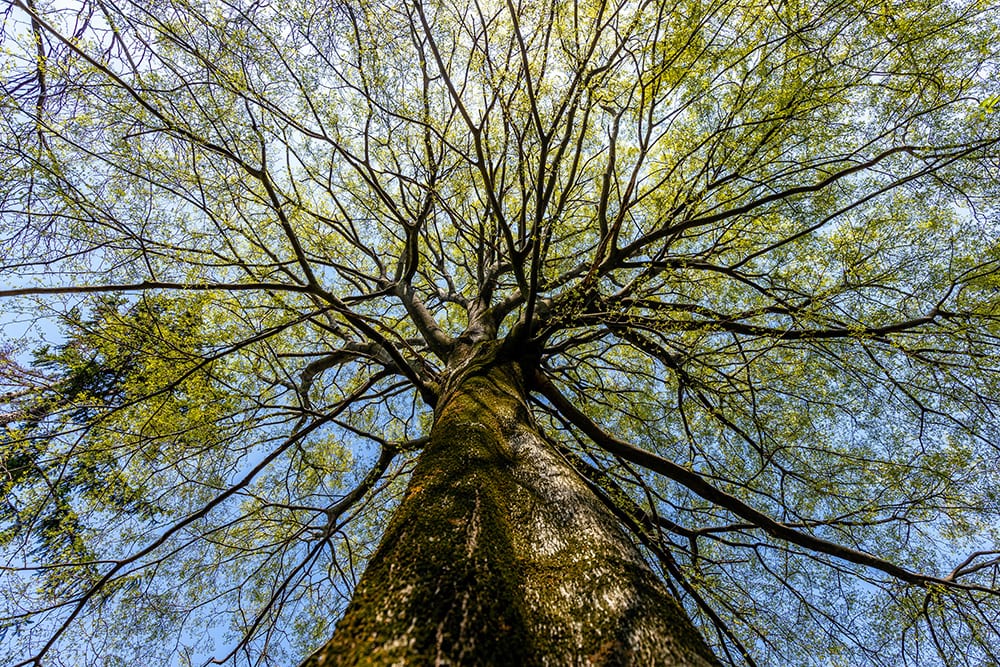
| Height: | 40-60 feet |
| Spread: | 40-60 feet |
The Hackberry tree is often well known for its wide range of adaptability, able to survive in some less than favorable conditions. Hackberries that grow on this species are completely edible and nutritious.
22. American Elm

| Height: | 60-80 feet |
| Spread: | 60-120 feet |
The American Elm grows substantially large and has immaculate shade coverage. These massive trees, unfortunately, suffered a significant decline after Dutch elm disease was spread rapidly by bark beetles.
23. Slippery Elm
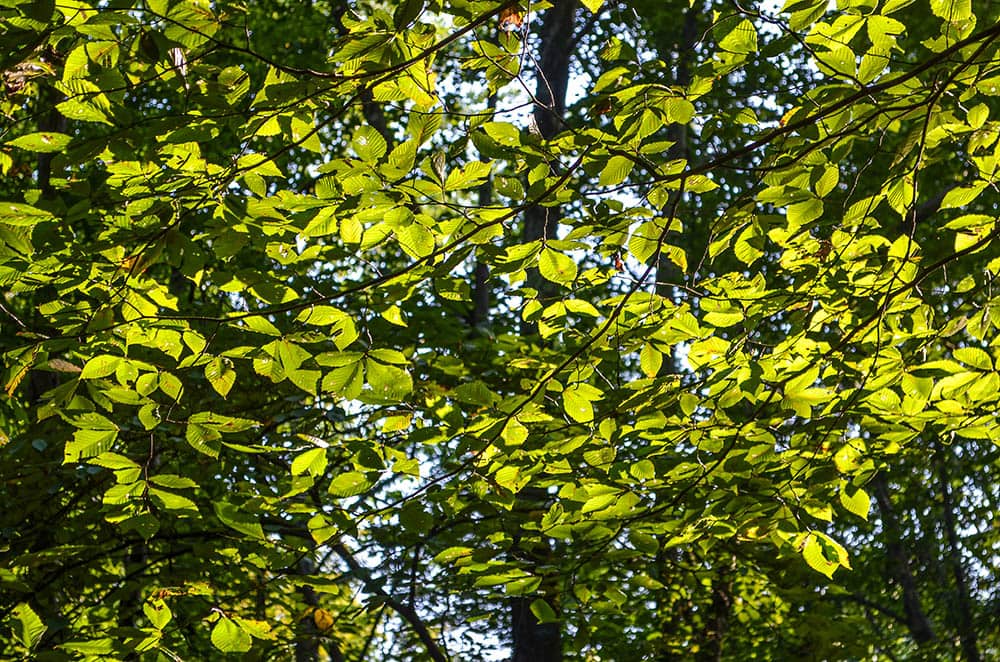
| Height: | 40-60 feet |
| Spread: | 25-35 feet |
The Slippery Elm has interesting bark patterns and sawtooth-shaped leaves. It doesn’t have as far of a spread as some elm cousins, but it still provides adequate shade and bears fruit.
Ebony Family
24. American Persimmons
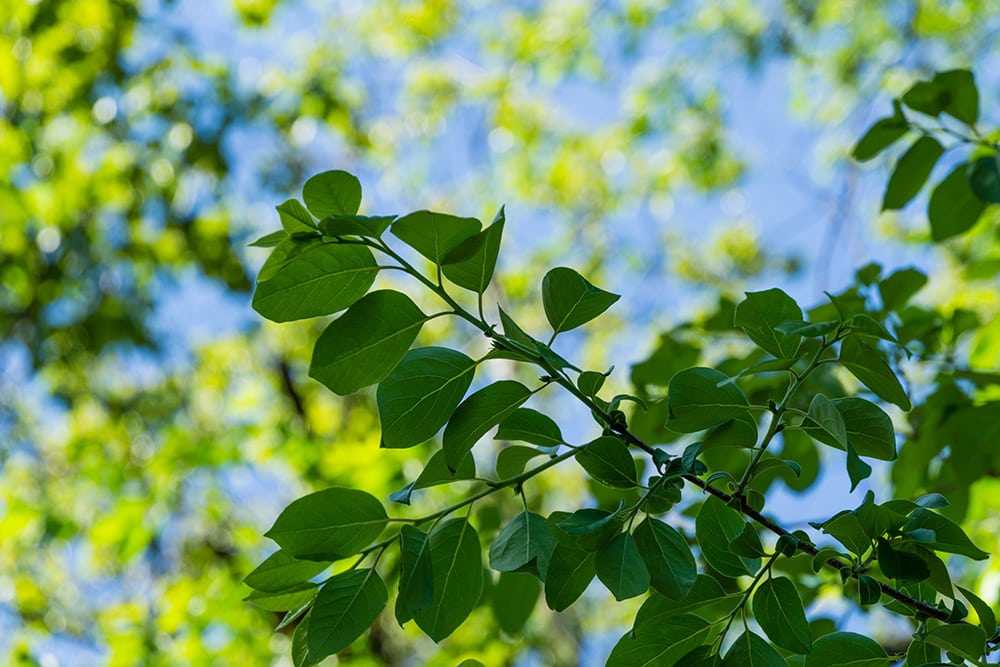
| Height: | 40-60 feet |
| Spread: | 25-30 feet |
The American Persimmons is a fruit-bearing native tree to Ohio. Persimmons fruits are often the same relative size and shape of peaches but have a taste quality of cantaloupe.
Horsechestnut Family
25. Ohio Buckeye
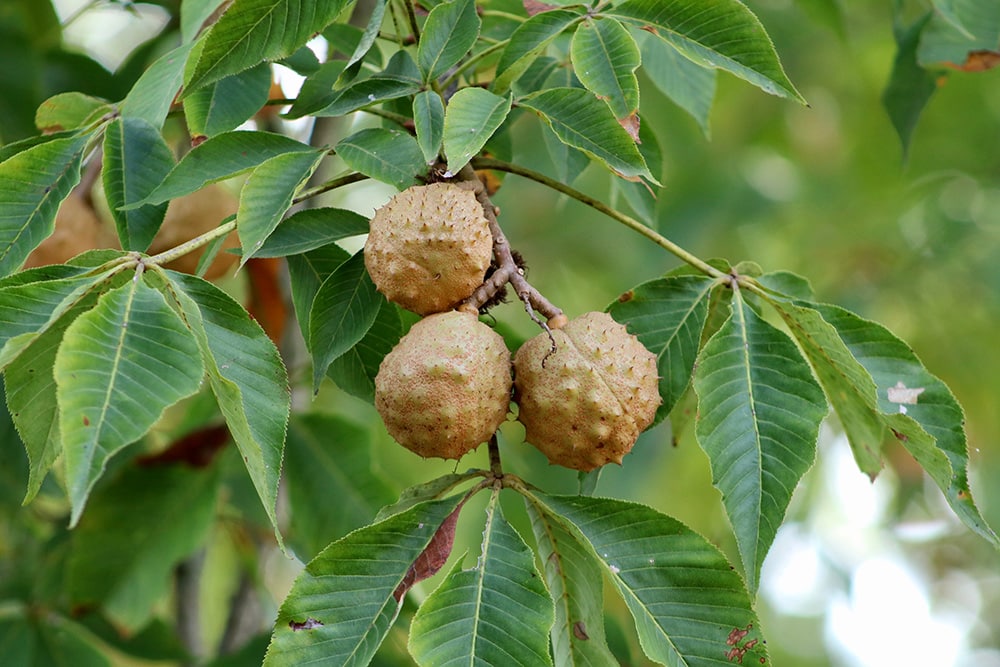
| Height: | 50-60 feet |
| Spread: | 35-45 feet |
The Ohio Buckeye tree is a trademark symbol of the state. These trees produce flowers in the spring which grow to buckeyes over the summer months, developing inside prickly outer casings.
26. Yellow Buckeye
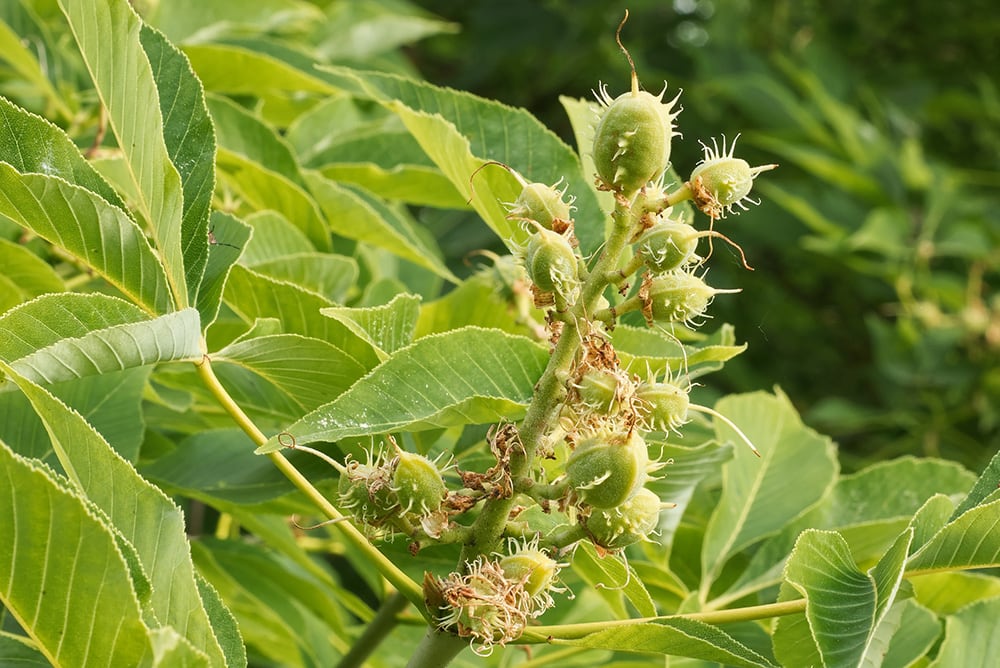
| Height: | 60-75 feet |
| Spread: | 30-35 feet |
The Yellow Buckeye has a yellow-green to its leaves and tends to grow much larger than the Ohio Buckeye. It produces the same fruit, but the tree grows upward and spreads in an oval fashion.
Laurel Family
27. Sassafras
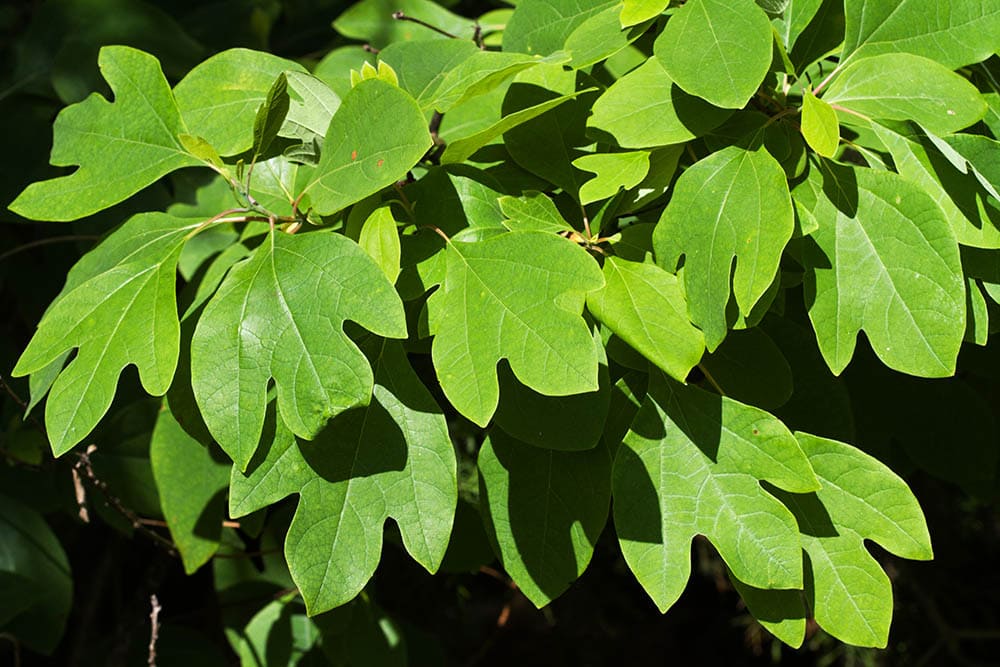
| Height: | 30-60 feet |
| Spread: | 20-40 feet |
The Sassafras tree has many medicinal benefits and is lovely in composition. This tree is highly aromatic and is often used in teas and for scents. It’s also very beautiful in the fall months when it’s most vibrant.
Linden Family
28. American Basswood

| Height: | 75-130 feet |
| Spread: | 70-90 feet |
The American Basswood is a tall tree with heart-shaped leaves. It’s often used for residential areas due to its beautiful springtime flowering, attracting bees and birds.
Magnolia Family
29. Cucumbertree
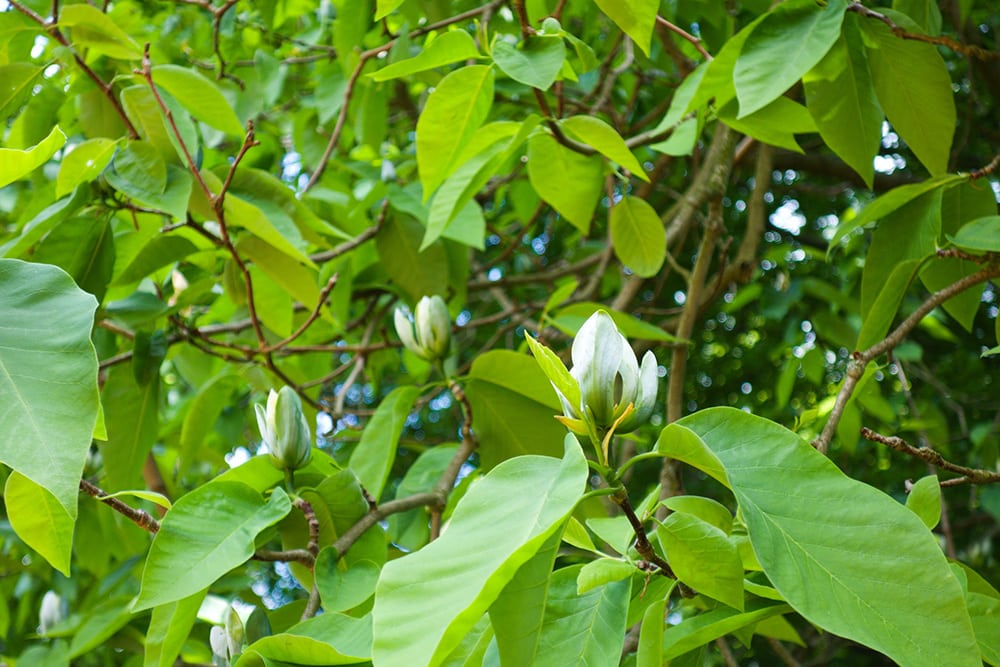
| Height: | 60-75 feet |
| Spread: | 60-75 feet |
The Cucumbertree is a fragrant flowering tree in the magnolia family. It gets its name from the pinkish fruit it produces that grows in the shape of a cucumber.
30. Yellow Poplar
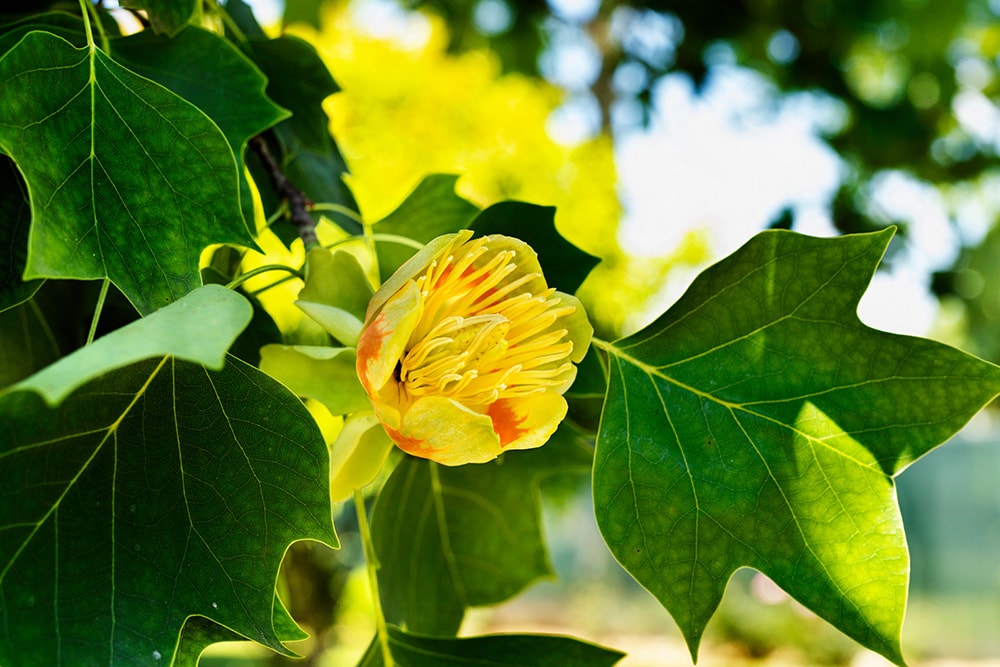
| Height: | 70-90 feet |
| Spread: | 40-45 feet |
The yellow polar, also known as the tulip tree, is a lovely large-leaved orange flowering tree. These fast growers can get tall and are generally straight up with tight upward branches.
Maple Family
31. Boxelder
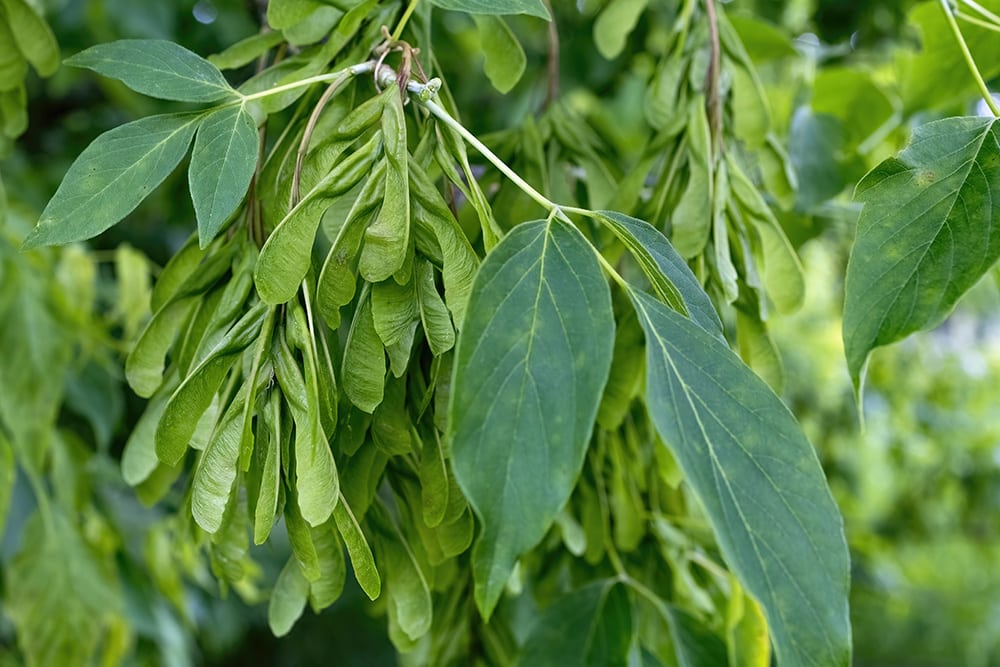
| Height: | 30-50 feet |
| Spread: | 25-45 feet |
The boxelder is a standard smaller maple known for its helicopter-like seedlings. When they let go, these small pods twirl to the ground, giving off the impression of a helicopter spinning.
32. Red Maple

| Height: | 40-60 feet |
| Spread: | 40 feet |
The red maple is known for its deep to fiery leaves in the fall. They can produce tiny white flowers in the early months. It’s often used in yards since it’s aesthetically pleasing, but it can sometimes be toxic to horses.
33. Silver Maple
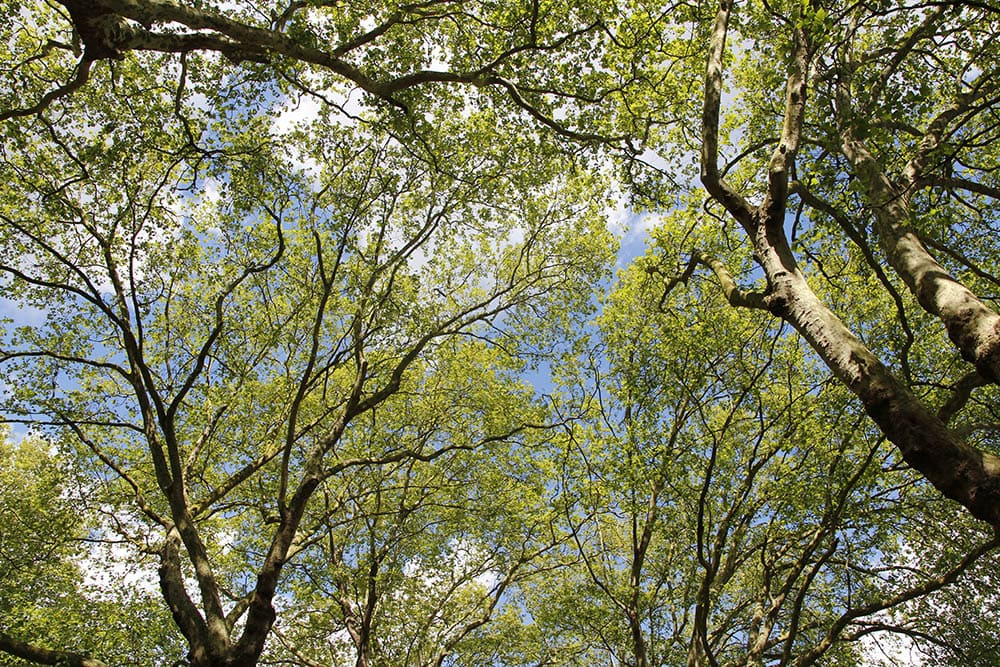
| Height: | 50-80 feet |
| Spread: | 35-50 feet |
The tree gets the name Silver Maple from the silvery tomes on the underside of the leaves. It tends to be an aggressive rooter, so it’s best to keep these trees away from pipelines and sidewalks.
34. Sugar Maple
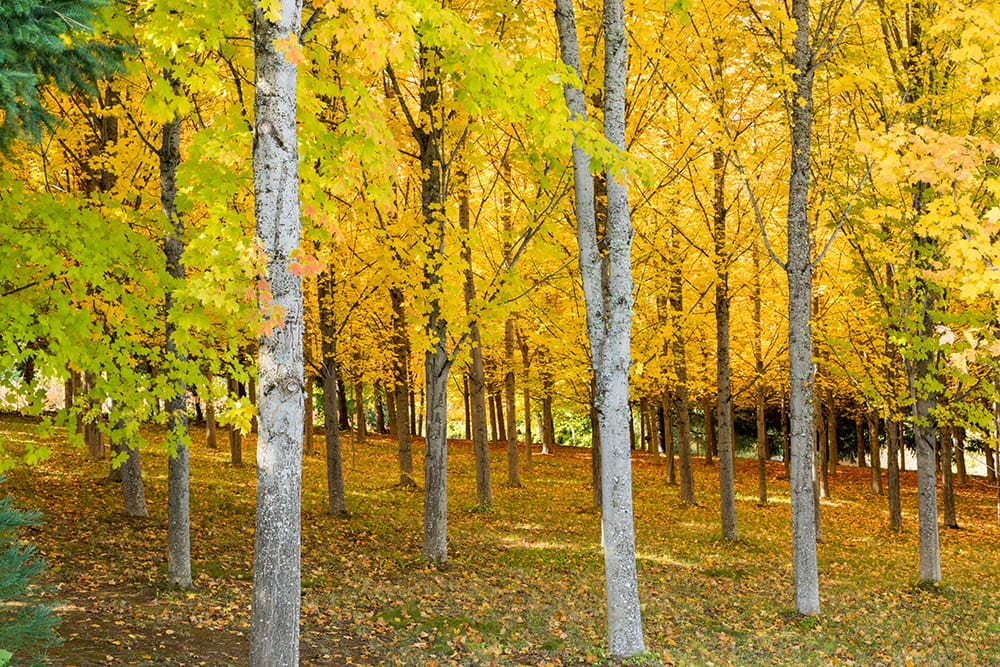
| Height: | 60-75 feet |
| Spread: | 40-50 feet |
Sugar maples are loved for many reasons—from their syrup production to the fantastic colors they turn in the autumn months. It tends to grow very symmetrically in a circular fashion providing excellent shade coverage.
Mulberry Family
35. Osage Orange
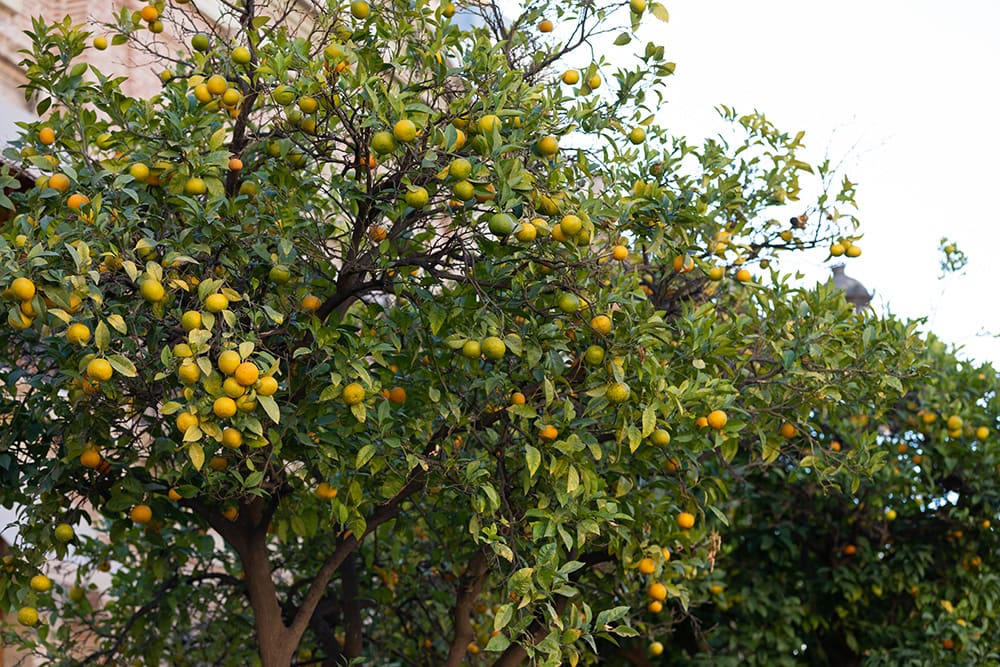
| Height: | 30-40 feet |
| Spread: | 20-30 feet |
Known for its intriguing hedge apple fruits, the Osage Orange tree resides in Ohio’s forests. It’s rumored to keep away spiders and other insects. It’s also fast-growing and able to withstand a variety of environmental conditions.
36. Red Mulberry

| Height: | 35-40 feet |
| Spread: | 40 feet |
The Red Mulberry is a very beautiful fruit bearing tree in Ohio that produces oblong, deep purple berries. It has very beneficial properties for soil, making it a delight to have in parks or personal properties.
Olive Family
37. Green Ash
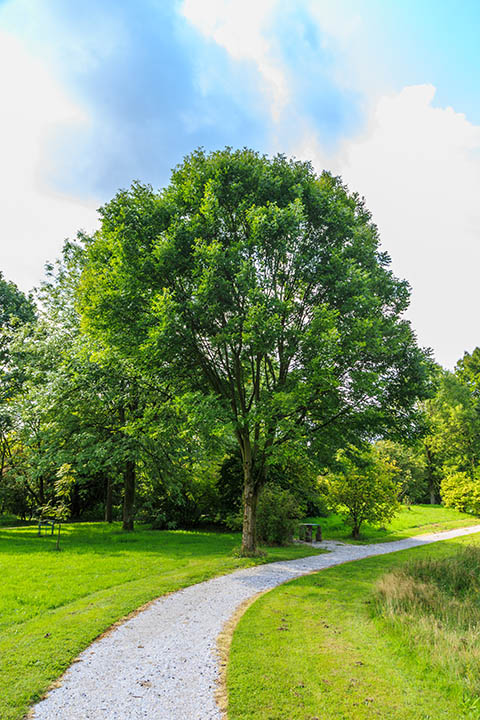
| Height: | 50-60 feet |
| Spread: | 25 feet |
The Green Ash tree is a tall, thin tree with elongated leaves and reddish-purple fruits. This is a perfect tree for shade and will adapt to even unpleasant, harsh soil conditions. It also grows with a classic canopy to block sunlight.
38. White Ash
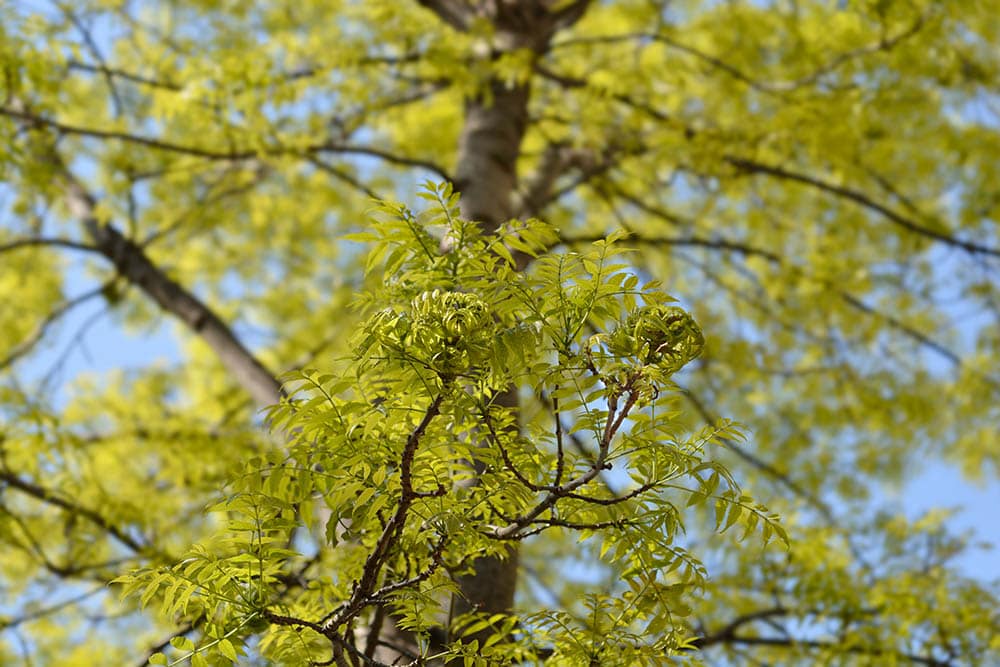
| Height: | 50-80 feet |
| Spread: | 40-50 feet |
The White Ash tree is classically used to make baseball bats due to the wood texture. It also is a fall favorite, sporting gorgeous colors in the fall months. However, both the White and Green Ash trees are coming under attack emerald ash borer.
Plane Tree Family
39. American Sycamore
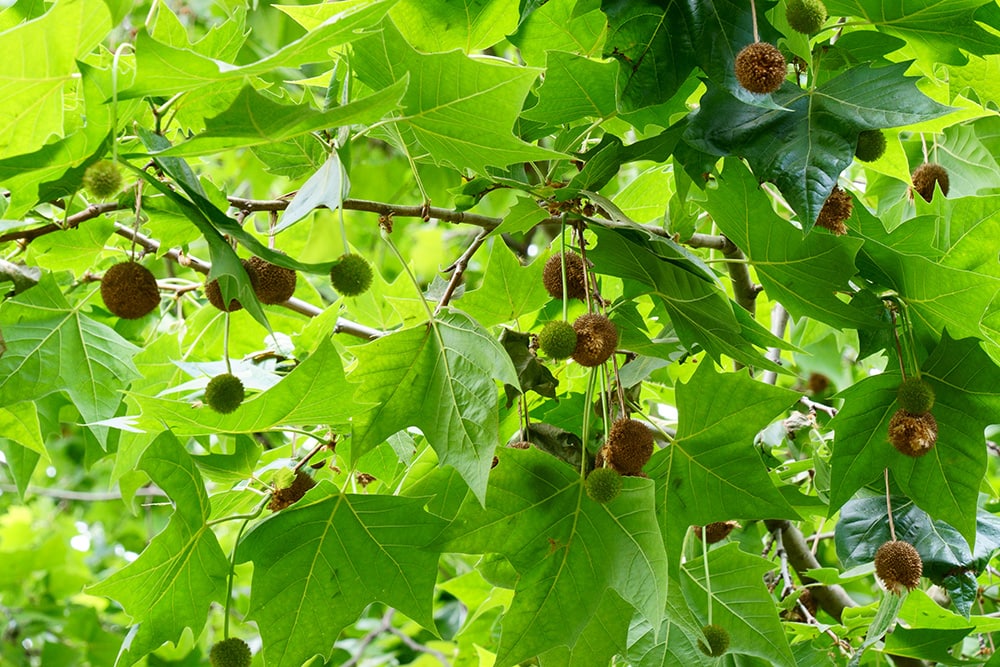
| Height: | 75-100 feet |
| Spread: | 75-100 feet |
The American Sycamore is a water-loving tree, finding its home by creeks, streams, and other water sources. Touting white and gray smooth bark and twisty branches, this tree is easy to identify. They have a larger trunk diameter than any other native hardwood tree.
Rose Family
40. Black Cherry
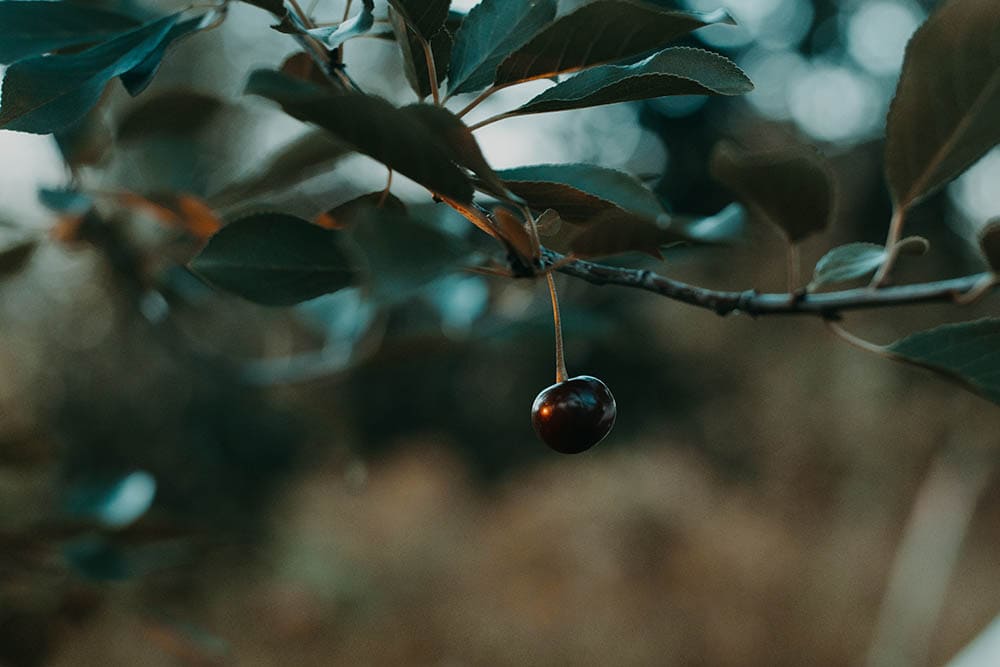
| Height: | 70-80 feet |
| Spread: | 80-100 feet |
Even though the Black Cherry is considered invasive in Europe, it’s very beneficial to butterflies and moths in Ohio. It is mainly used as an ornamental tree, producing beautiful fruit that feeds surrounding wildlife.
Tupelo Family
41. Blackgum

| Height: | 30-50 feet |
| Spread: | 20-30 feet |
The Blackgum tree is a smaller Ohio native that loves moist well-drained soils, though it can tolerate mild drought. It has deeply ridged bark and the green, glossy leaves turn bold colors of orange and yellow in the autumn months.
Walnut Family
42. Butternut

| Height: | 40-60 feet |
| Spread: | 35-50 feet |
The Butternut tree is a relatively widespread tree, often used in landscapes. However, it emits juglones which can affect gardens, so keeping it as a standalone tree is recommended.
43. Black Walnut
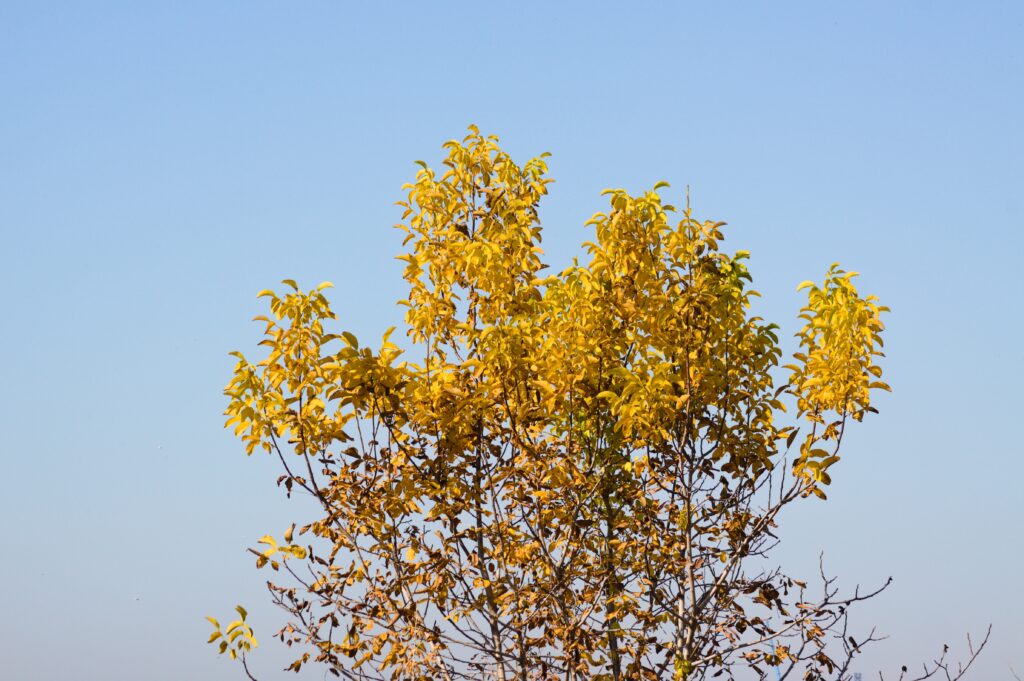
| Height: | 50-150 feet |
| Spread: | 50-75 feet |
Black walnut trees are useful for people and wildlife alike. However, the nut fruit it produces is notorious for staining fingers and clothes. Like other walnut varieties, the roots produce juglone, which can be toxic to surrounding plant life.
44. Bitternut Hickory
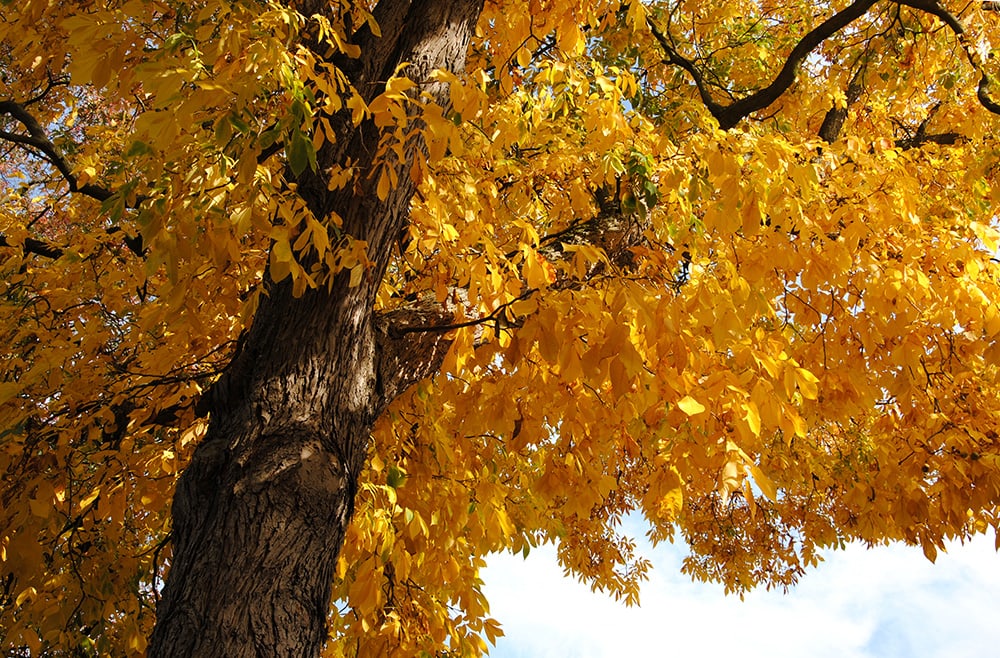
| Height: | 40-50 feet |
| Spread: | 40 feet |
The Bitternut Hickory is a large pecan hickory that produces fruits. It is the fastest-growing Hickory tree in Ohio. They are often commercially grown, bought, and sold due to the desirable quality of their wood.
45. Mockernut Hickory
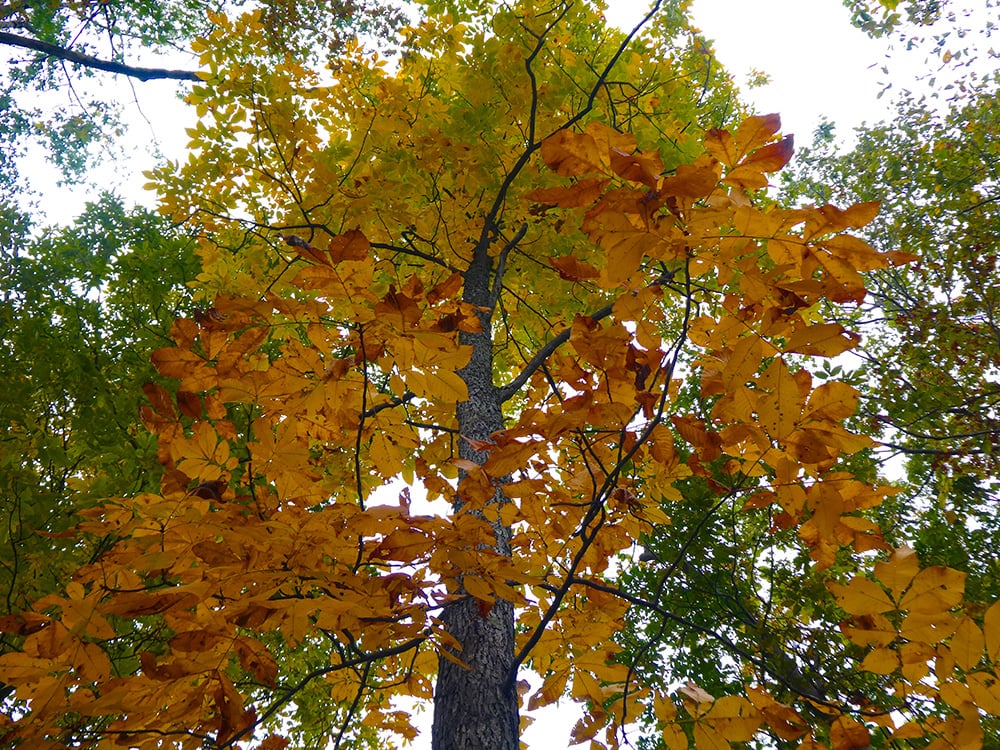
| Height: | 50-90 feet |
| Spread: | 40 feet |
The Mockernut Hickory loves moist climates and thrives well in humidity. These Hickory trees haVE male and female flowers produced on the same tree and develop nut casings in the fall.
46. Pignut Hickory
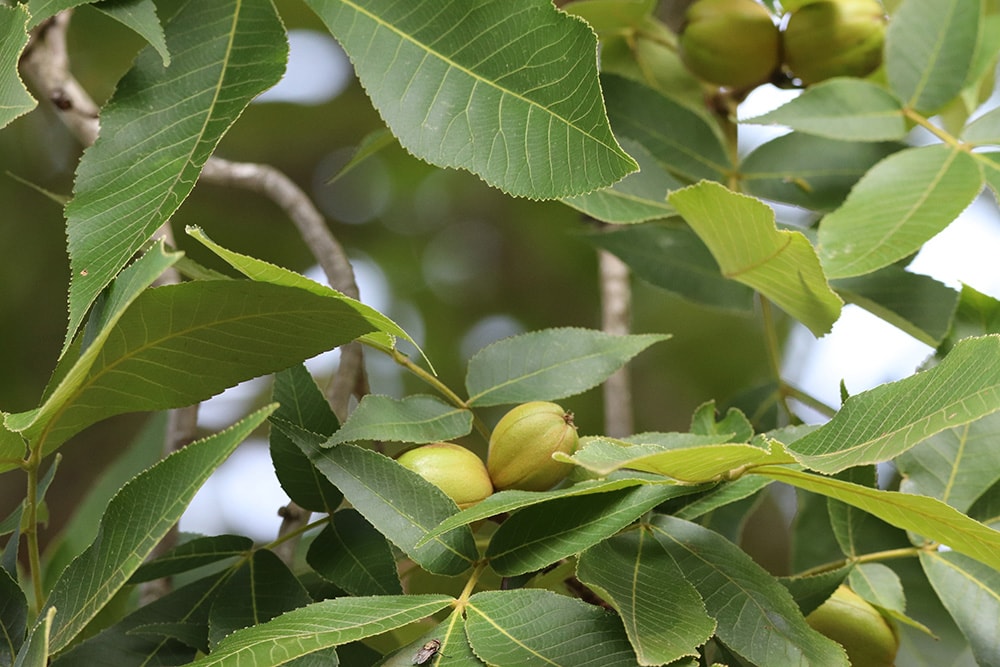
| Height: | 50-60 feet |
| Spread: | 25-30 feet |
The Pignut HIckory grows very tall, but it’s a slow-growing tree. It produces a green bitternut that is specific to the species.
47. Shagbark Hickory
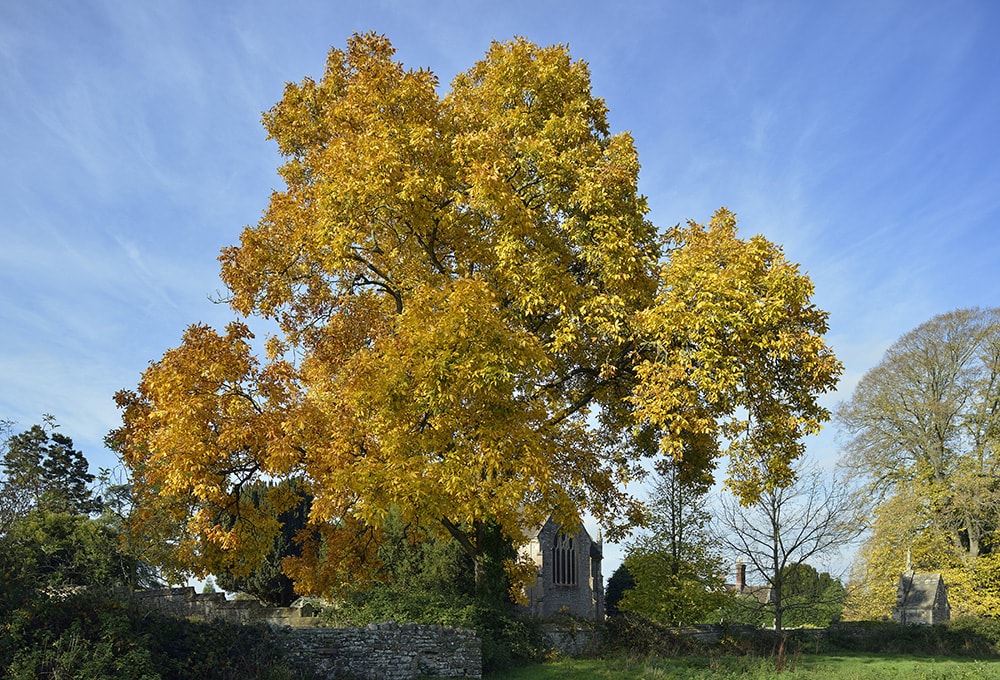
| Height: | 60-80 feet |
| Spread: | 20-30 feet |
The Shagbark Hickory grows upward with narrow open branching. The distinguishing feature is the classic Shagbark that is usually gray in color and looks loose and frayed.
48. Shellbark Hickory

| Height: | 60-80 feet |
| Spread: | 40 feet |
The Shellbark Hickory is often confused with the Shagbark Hickory, but you can distinguish the two by their leaves. Shellbark has seven leaflets, whereas Shagbark has five.
Willow Family
49. Bigtooth Aspen
| Height: | 60-80 feet |
| Spread: | 40 feet |
The Bigtooth Aspen is a tap oval shaped tree that provides decent shade: these trees love the sun and prefer to grow in areas that get plenty of it.
50. Black Willow
| Height: | 10-60 feet |
| Spread: | 30-50 feet |
The beautiful Balck Willow is the largest Willow of the New World. They are masters at preventing soil erosion and thrive next to water sources. They are ideal next to ponds and creeks but may hog water from other trees.
51. Eastern Cottonwood
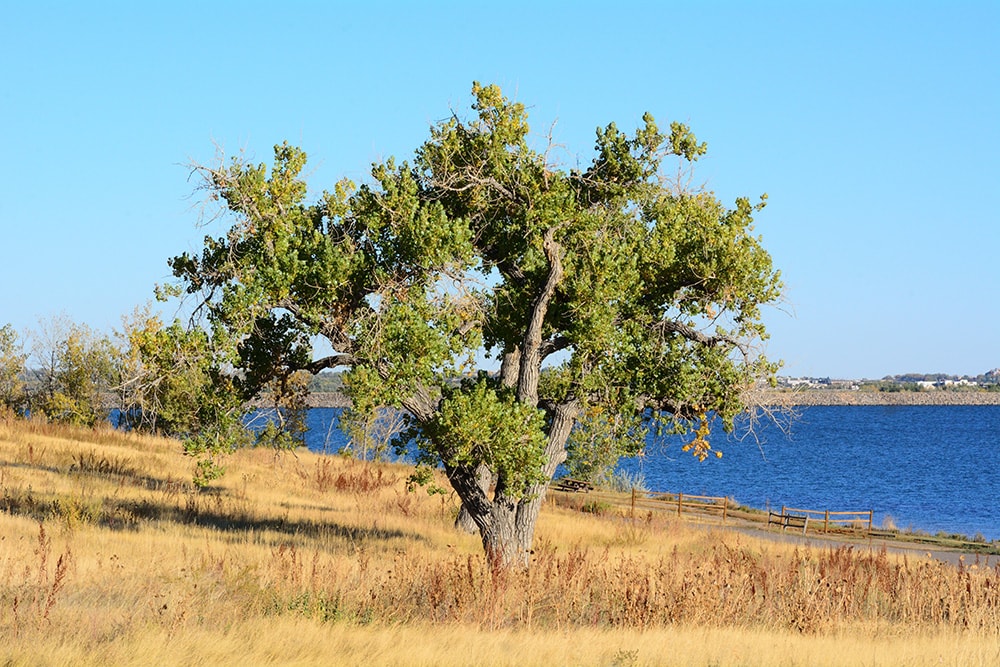
| Height: | 100+ feet |
| Spread: | 100+ feet |
The Eastern Cottonwood is stunningly fast growing, gaining roughly six feet annually. It produces fluffy cotton blooms that can contribute to allergies, but these trees make for great climbing.
Witchhazel Family
52. Sweetgum
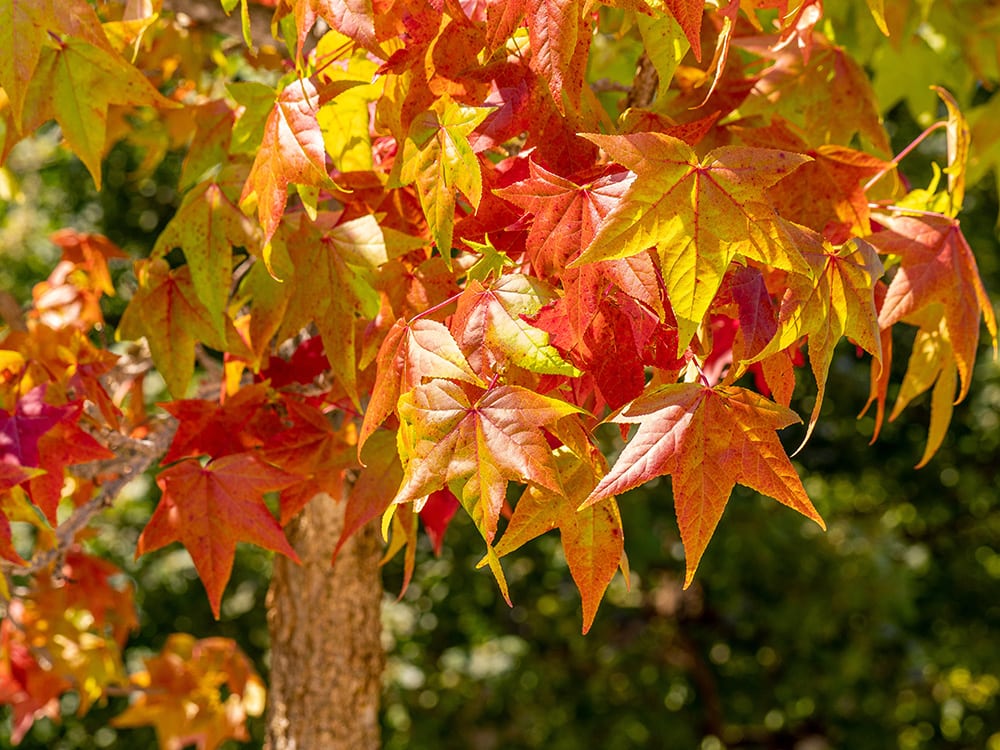
| Height: | 60-75 feet |
| Spread: | 40-50 feet |
The Sweetgum has beautiful star-shaped leaves and grows pyramidal. They are stunning in the fall months, turning shades of burnt orange and purple. These trees need plenty of root space, so they do best in open spaces.
 Coniferous Trees
Coniferous Trees
Coniferous trees are seed-bearing cone plants that stay green year-round.
Pine Family
53. Colorado Blue Spruce

| Height: | 50-75 feet |
| Spread: | 10-20 feet |
The Colorado Blue Spruce is a spiny pine with a frosted bluish-green hue. These conifers are one of the most popular Christmas tree choices due to its symmetry and color.
54. Norway Spruce
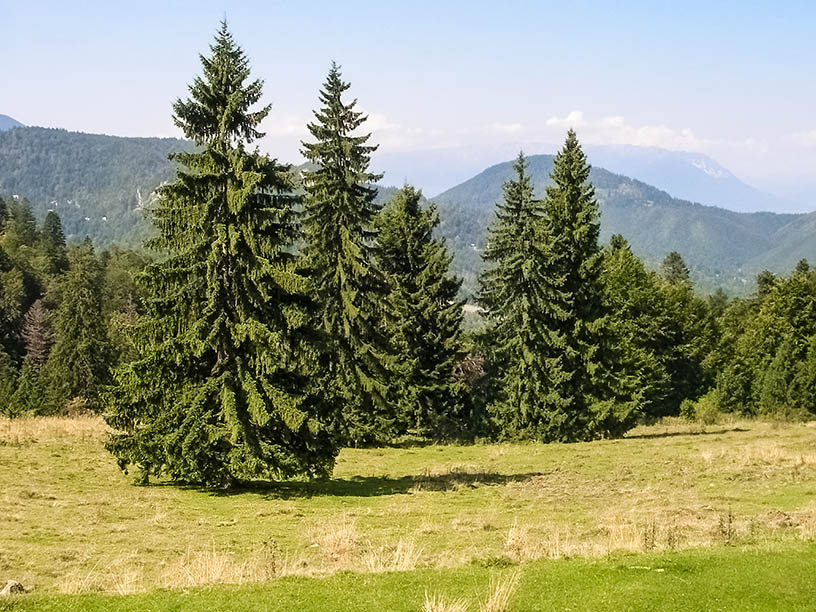
| Height: | 40-60 feet |
| Spread: | 25-30 feet |
The Norway Spruce is the fastest-growing of all spruce trees, making them perfect for newly built homes. They make excellent windbreakers due to their strong branches and needles.
55. Eastern Hemlock

| Height: | 70 feet |
| Spread: | 30 feet |
The Eastern Hemlock is a very common conifer in Ohio. It is incredibly shade tolerant, making them appealing for areas that don’t get a lot of sunlight.
56. Australian Pine
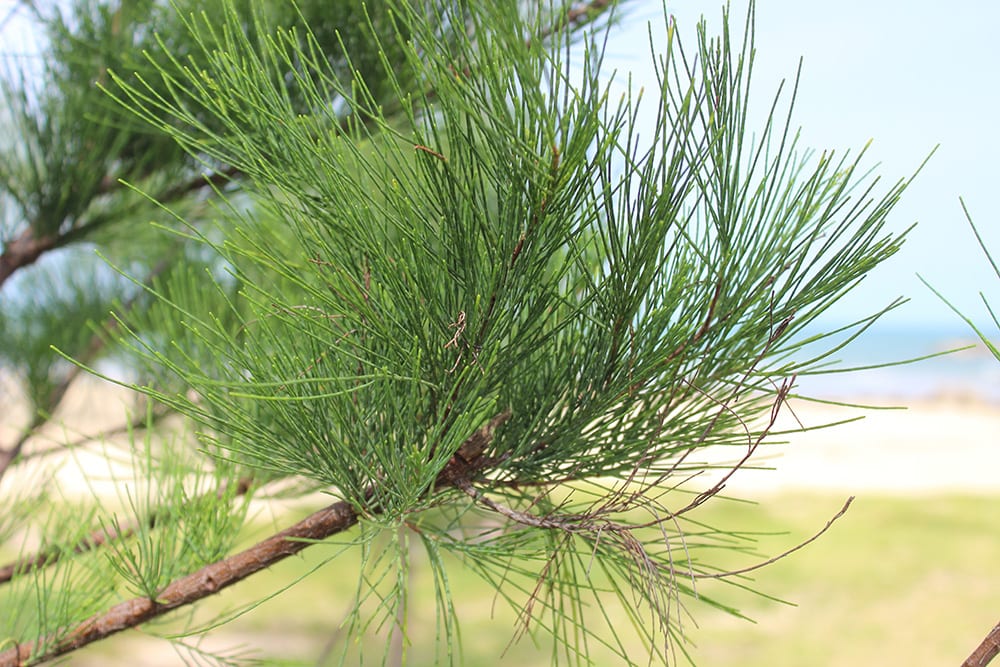
| Height: | 50-60 feet |
| Spread: | 20-40 feet |
The Australian Pine is an incredibly fast-growing, hardy pine tree that thrives in less than optimal conditions. It can even survive in clay-based soils and near seasides.
57. Eastern White Pine
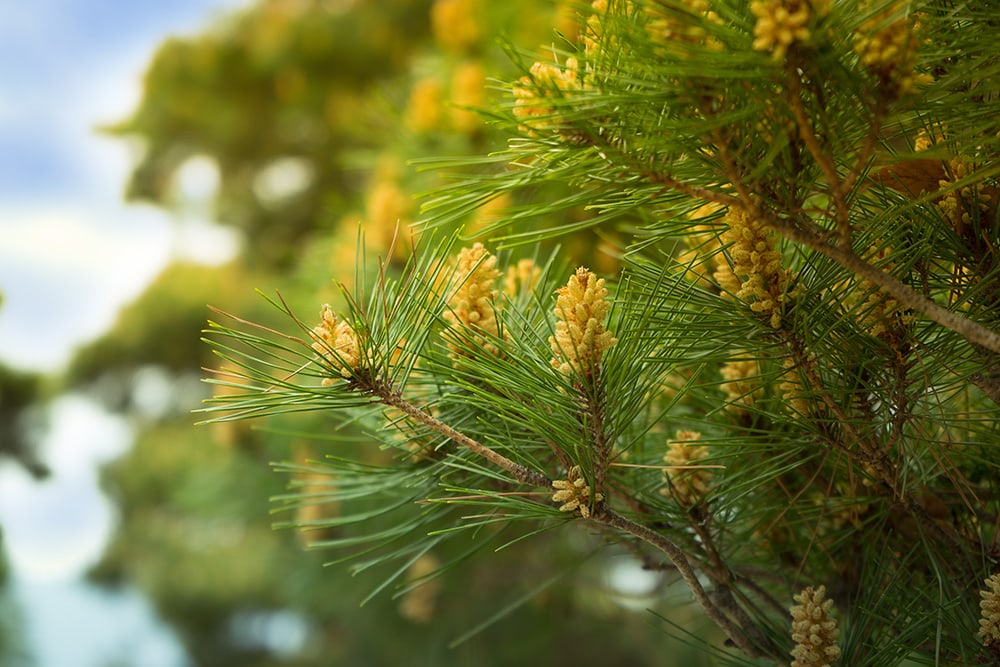
| Height: | 50-80 feet |
| Spread: | 20-40 feet |
The Eastern White Pine is notably lovely with its sprawling, soft long needles and clustered open pine cones. These trees grow in a lovely oval shape and make fabulous Christmas trees.
58. Loblolly Pine
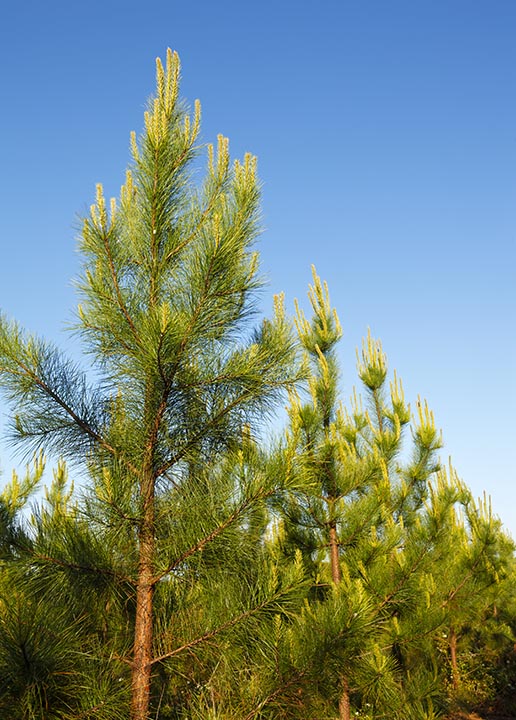
| Height: | 60-90 feet |
| Spread: | 25-35 feet |
The Loblolly Pine grows very tall and narrow, but as it ages, it loses its bottom branches. It’s often a great choice for a shade tree and the lime green needles are unique and gorgeous.
59. Pitch Pine
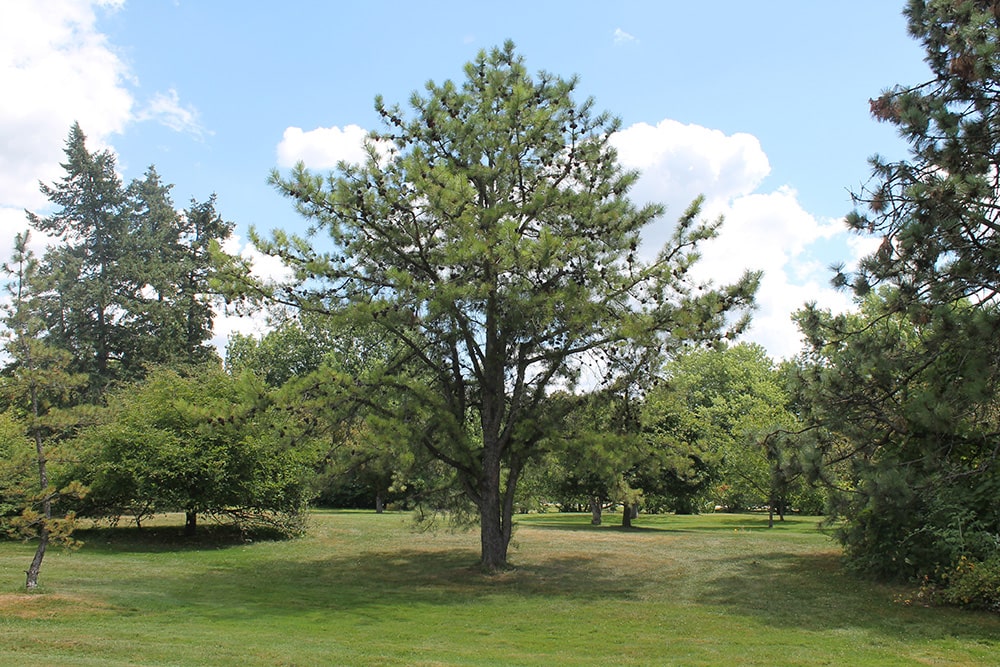
| Height: | 20-90 feet |
| Spread: | 30-50 feet |
The Pitch Pine has quite a wide range of growth that depends on the environment it’s in. What’s unique about this tree is that the trunk is fire-resistant, building up defenses against forest fires.
60. Red Pine
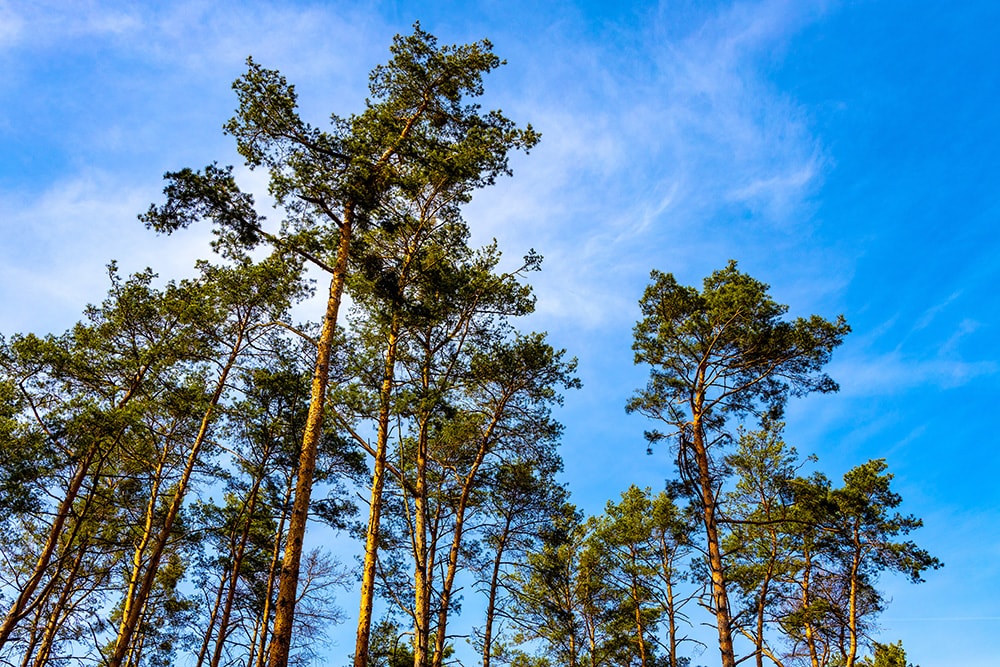
| Height: | 50-100 feet |
| Spread: | 30 feet |
The Red Pine is known for its straight upward trunk and narrow spread. They grow impressively, growing more than two feet every year. This type of tree works wonderfully in the lumber industry.
61. Scotch Pine

| Height: | 50-60 feet |
| Spread: | 40 feet |
The Scotch Pine is an incredibly hardy tree tolerating all sorts of harsh environments. They have interesting branching patterns, creating trusty whimsical branches.
62. Shortleaf Pine

| Height: | 50-100 feet |
| Spread: | 20-35 feet |
The Shortleaf Pine is a drought-hardy conifer that can survive in minimal to moderate moisture conditions. It’s also a full sun tree that thrives with direct light.
63. Virginia Pine
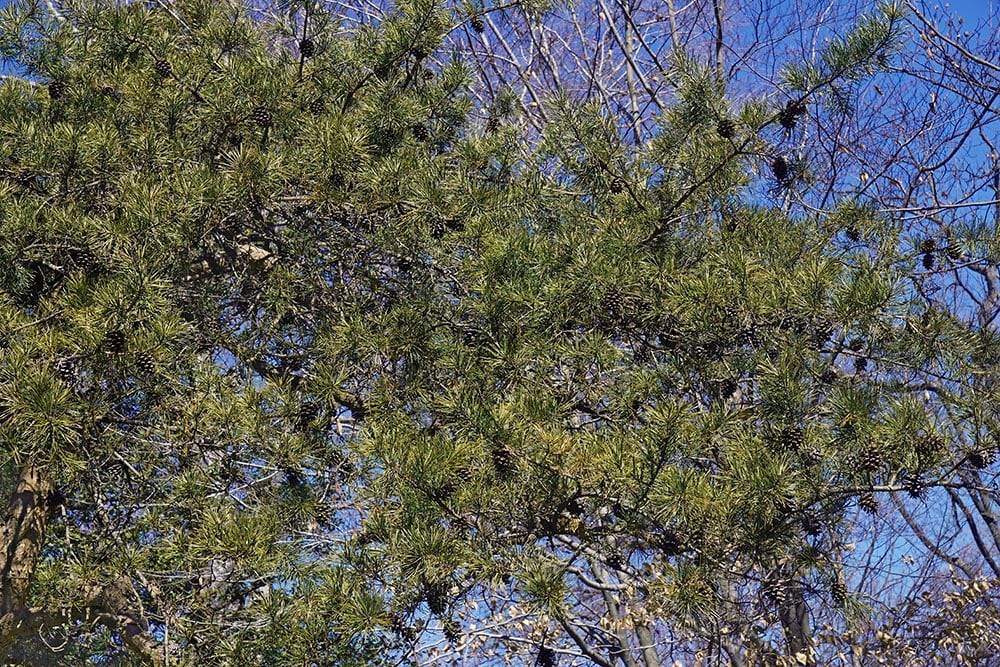
| Height: | 70 feet |
| Spread: | 20-30 feet |
The Virginia Pine is an ultra-adaptable pine tree that can grow just about anywhere. The lovely needles of this pine are covered in smaller prickly cones.
Cypress Family
64. Eastern Redcedar
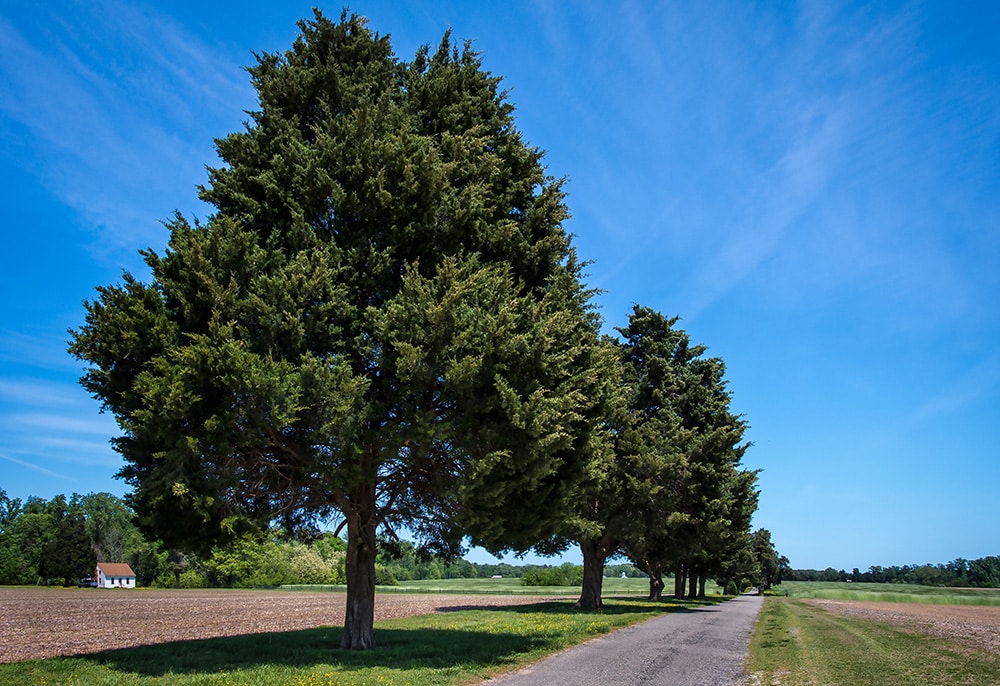
| Height: | 40-50 feet |
| Spread: | 8-20 feet |
The Eastern Redcedar is the only tree in Ohio in the Cypress family. These trees develop yummy berries that birds love, but humans can’t eat. They develop deep roots and are fabulous windbreakers. However, Cedar-apple rust is possible, so they shouldn’t be planted near apple trees.
Invasive Tree Species
65. Callery Pear
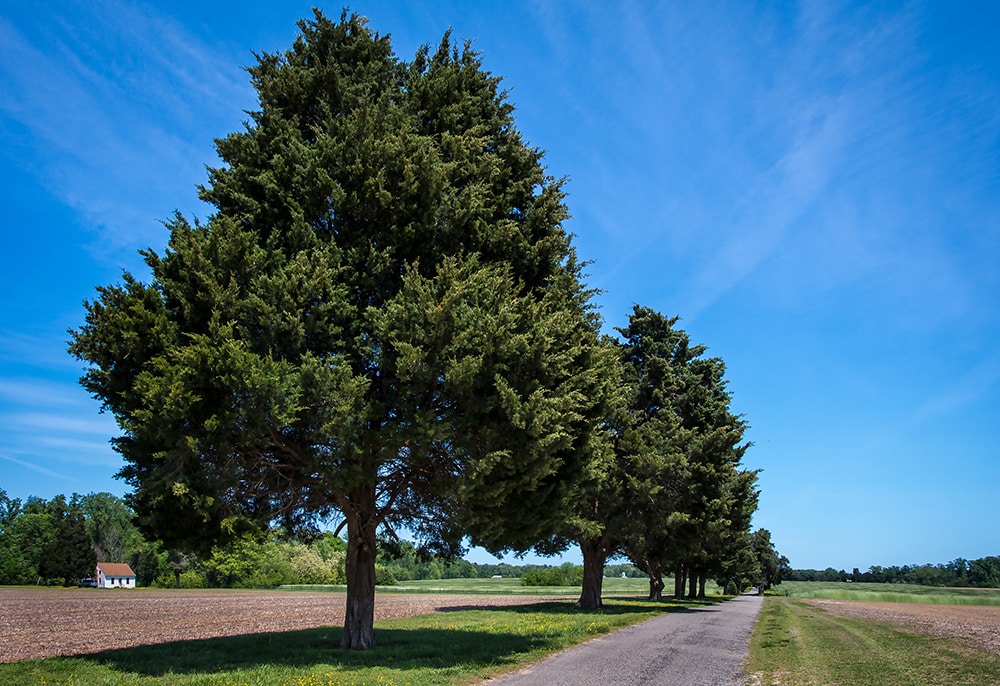
| Height: | 25-35 feet |
| Spread: | 15-25 feet |
The Callery Pear tree is a native tree to Asia. Even though the beautiful spring flowers and developing fruits look beautiful, this tree is considered ever-growing invasive and planted for ornamental purposes. The fruit they develop is not edible to humans, but it can support local wildlife.
66. Sawtooth Oak
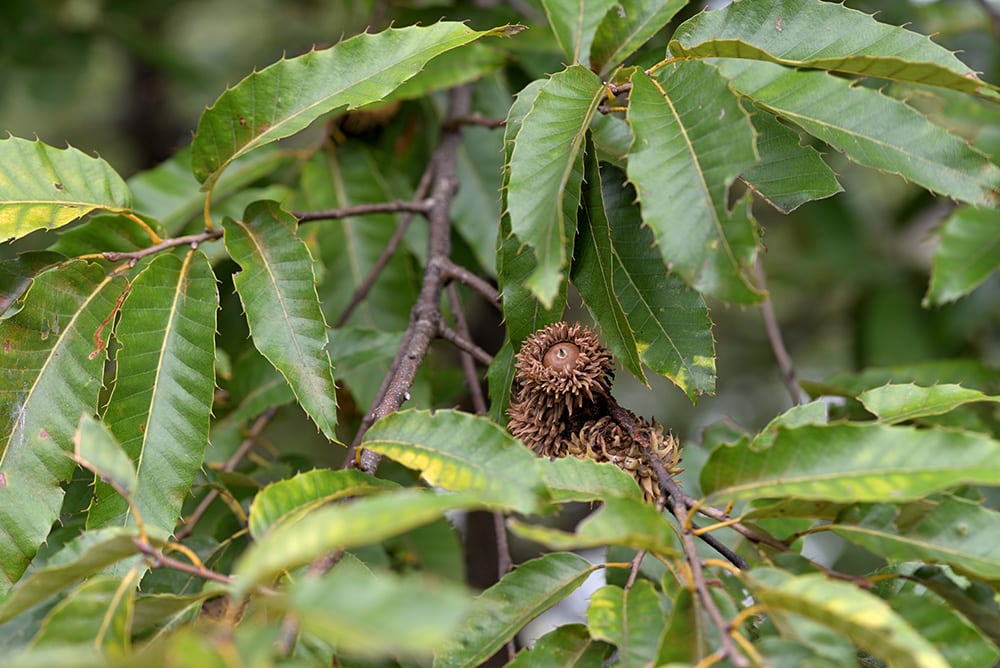
| Height: | 40-60 feet |
| Spread: | 40-60 feet |
The Sawtooth Oak is a very fast-growing tree with quick acorn development. It is often revered as a terrific food source for local wildlife. However, it is originally from Asia, not introduced to Ohio until 1862.
67. Siberian Elm
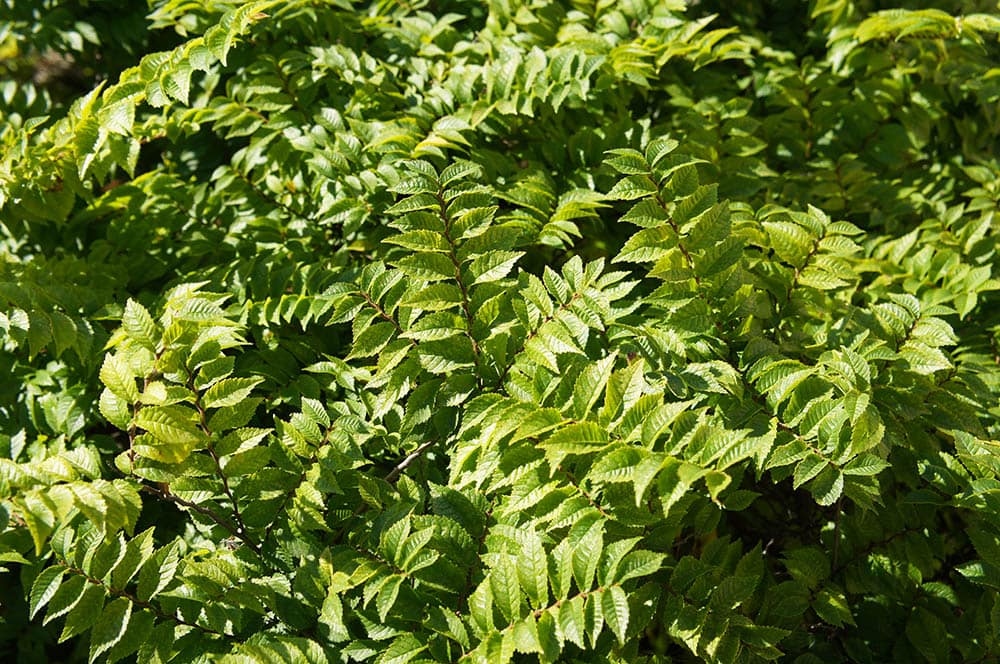
| Height: | 50-70 feet |
| Spread: | 35-50 feet |
Even though the Siberian Elm is relatively small in comparison to similar species, it grows rapidly. It’s a very aggressive species that can snuff out surrounding vegetation.
68. Tree of Heaven
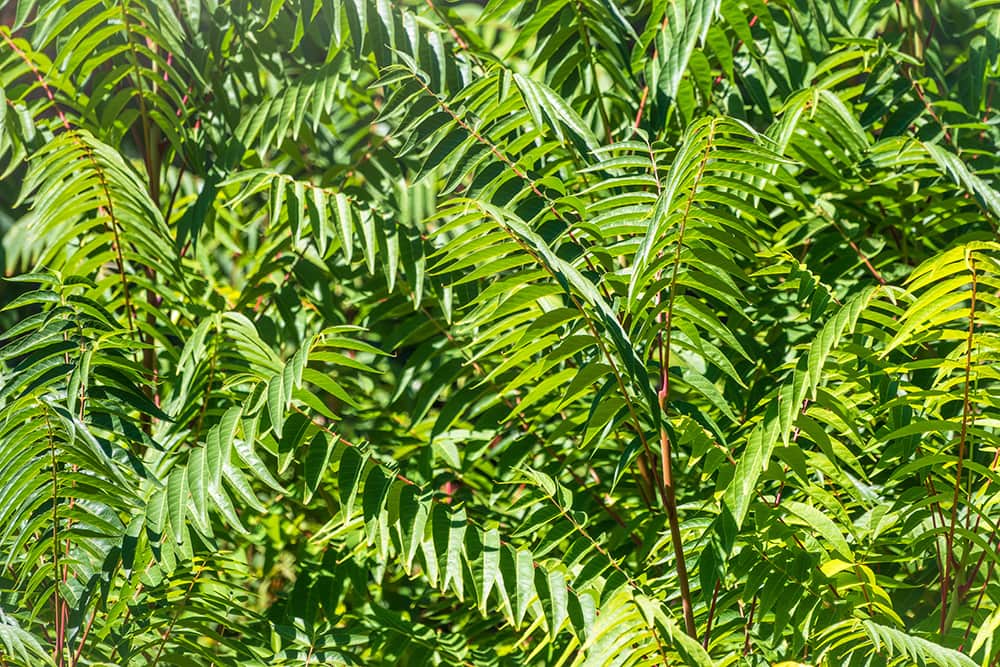
| Height: | 60-70 feet |
| Spread: | 40-50 feet |
The Tree of Heaven is a fast-spreading deciduous tree in Ohio. First used for its quick growth as ornamental trees, these trees have made their home in all parts of Ohio, quickly reproducing. It is drought and pollution tolerant, making it hard to stop.
69. White Mulberry
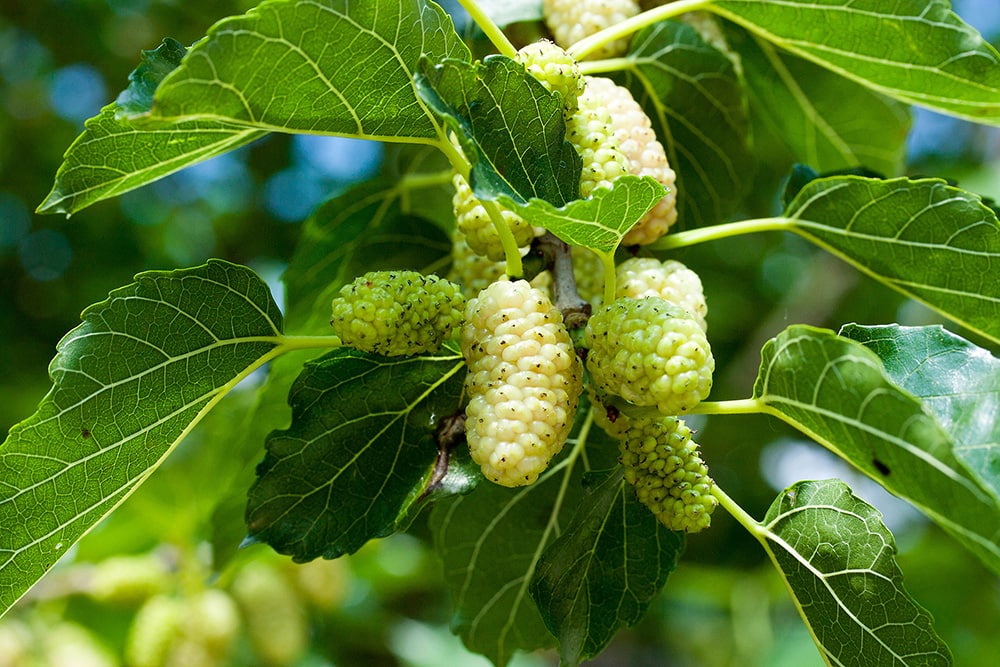
| Height: | 40-60 feet |
| Spread: | 40 feet |
The White Mulberry produces white berries, true to its name. Although you can eat fully ripened white mulberries, unripe berries contain a component called latex, which is harmful to humans.
Conclusion
Now, you have gotten familiar with all the tree species Ohio has to offer. There are several others we humans plant for ornamental purposes, but these trees are naturally occurring. They come in all different colors, sizes, and purposes.
Which Ohio tree is your favorite?
Featured Image Credit: Kenneth Sponsler, Shutterstock
Contents

 Coniferous Trees
Coniferous Trees